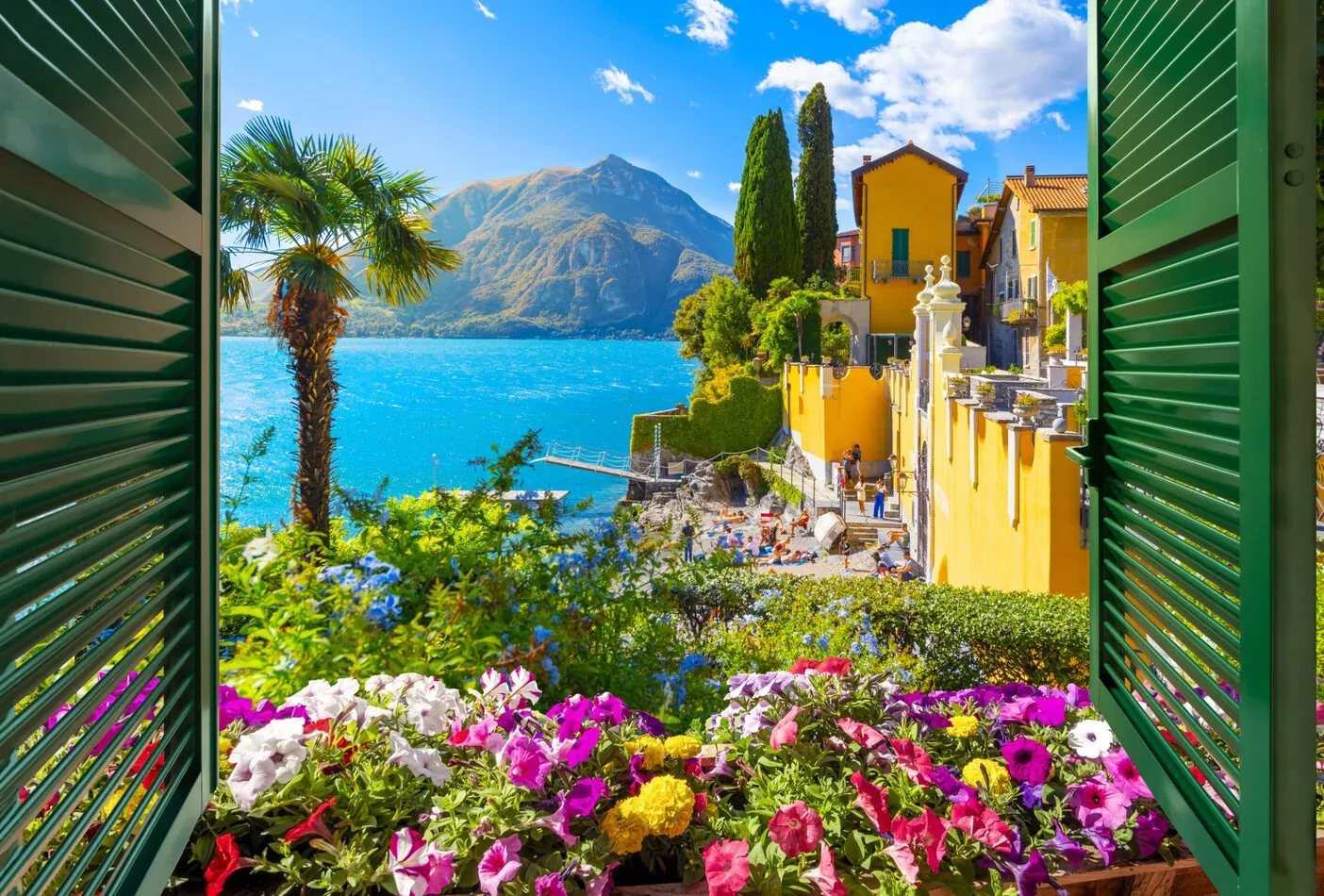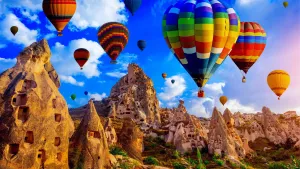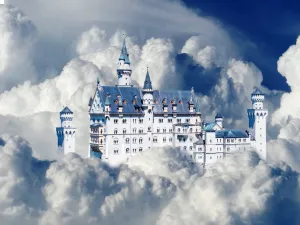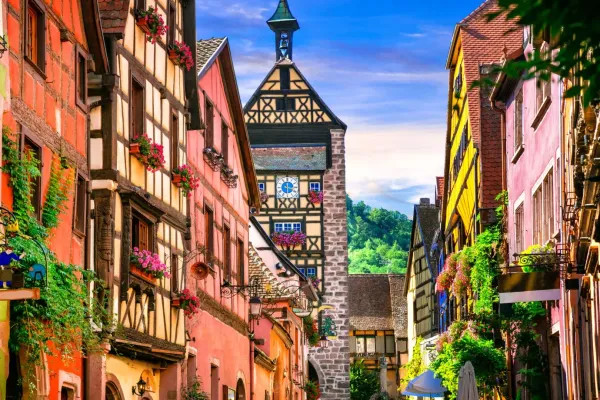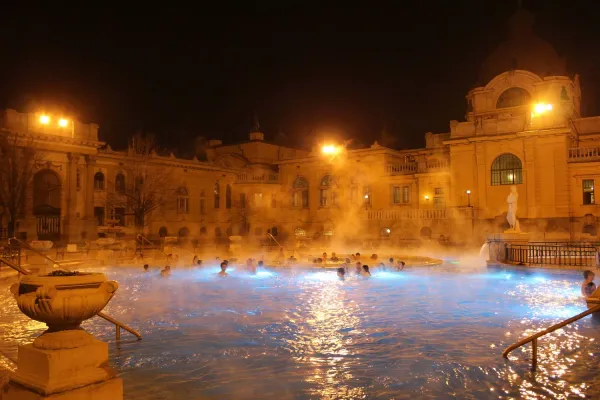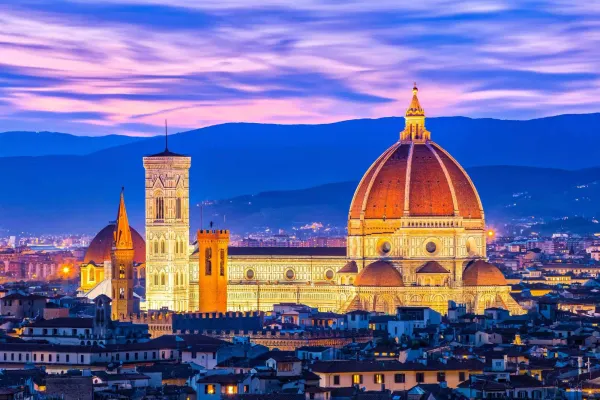Table of Content
- The Colosseum in Rome
- The Cinque Terre
- Leaning Tower of Pisa
- Venice Canals and Rialto Bridge
- Mount Etna, Sicily
- The Valley of the Temples, Sicily
- Lake Como
- Pompeii
- Amalfi Coast
- Capri
- Royal Palace of Caserta
- The Pantheon, Rome
- Vatican City
- Roman Forum, Rome
- Trevi Fountain, Rome
- The Spanish Steps, Rome
- Ostia Antica, Rome
- The Mausoleum of Hadrian, Rome
- Florence Duomo Santa Maria del Fiore
- The Uffizi Gallery, Florence
- Siena’s Historic Center
- Val d'Orcia, Tuscany
- San Gimignano, Tuscany
- Milan Duomo
- Galleria Vittorio Emanuele II, Milan
- Lago di Garda
- Verona: Arena and Romeo and Juliet's Balcony
- The Dolomites
- Lake Braies
- The Trulli of Alberobello
- Matera's Sassi, Basilicata
- Craco, Basilicata
Have you ever let your mind wander to the dreamlike realms of Tuscany, where the hills roll like waves of emerald and gold, and the air is filled with the promise of a Chianti savored in a sun-dappled café? Or perhaps you've imagined standing beneath the architectural marvel that is the Leaning Tower of Pisa, its storied tilt a testament to the wonders of history? If these dreams stir a longing within you, then an Italian escapade is calling your name. Italy is more than a mere travel destination; it's a vibrant mosaic of history, culture, and natural splendor, home to some of the world's most illustrious landmarks and awe-inspiring sights.
Envision yourself serenely cruising along the Venetian canals, each turn revealing another picturesque vista or wandering amidst the ancient, time-worn ruins of Pompeii, where history feels almost tangible. Picture yourself in the heart of Florence, surrounded by the sheer magnificence of Renaissance art and architecture, feeling the same inspiration that stirred the hearts of great artists.
Our detailed guide is your key to unlocking Italy's finest treasures. From the Alpine wonders in the north to the sun-kissed Sicilian coasts in the south, we'll take you on a journey through Italy's most cherished sites. Discover the hidden gems nestled in bustling cities and tranquil countryside alike. Whether you seek to delve into Italy's rich historical tapestry, immerse yourself in its diverse cultural fabric, or simply bask in the breathtaking beauty of its landscapes and urban wonders, our selection is designed to fulfill every aspect of your wanderlust.
As you join us on this enthralling exploration of Italy, we'll share insider tips, hidden spots, and the best ways to experience the essence of Italian life. From sampling the finest local cuisines to finding the perfect spot for that sunset view, our guide ensures your Italian journey is as enchanting and fulfilling as the country itself. Prepare to be captivated by the charm, elegance, and timeless beauty of Italy. Your dream Italian journey awaits, a tale of discovery, delight, and unforgettable experiences.
1. The Colosseum in Rome
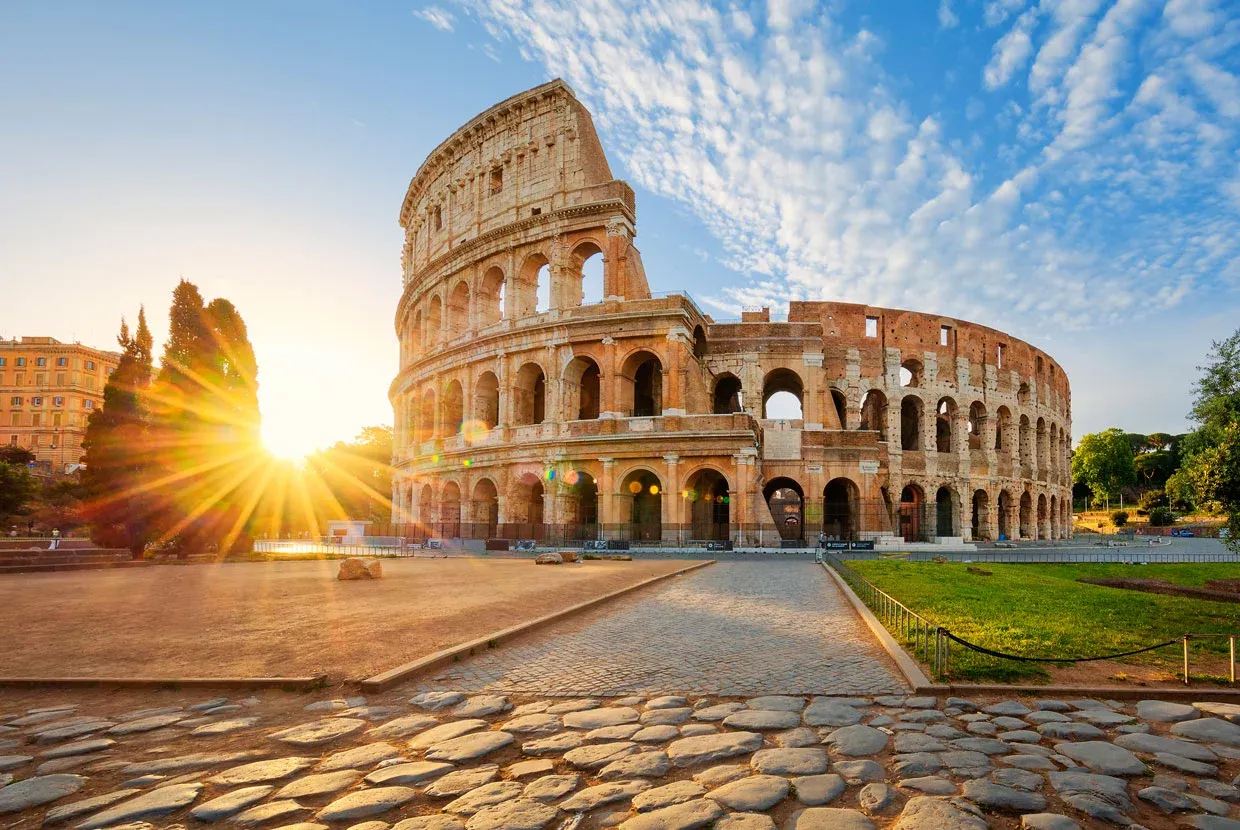
The Colosseum in Rome, also known as the Flavian Amphitheatre, is one of the most iconic and enduring symbols of ancient Roman engineering and architectural prowess. Constructed between A.D. 70 and 80 under the emperors Vespasian and Titus, this massive stone amphitheater was capable of seating around 50,000 spectators. It was primarily used for gladiatorial contests and public spectacles such as mock sea battles, animal hunts, executions, re-enactments of famous battles, and dramas based on Classical mythology.
One of the most remarkable aspects of the Colosseum is its ingenious design. The structure is elliptical, measuring about 189 meters long, 156 meters wide, and 50 meters high. This design was intended to facilitate crowd control and improve visibility for all spectators. It features a complex system of vaults and is constructed of travertine limestone, tuff (a form of volcanic rock), and brick-faced concrete, showcasing the Romans' mastery in the use of building materials.
The Colosseum had 80 entrances, ensuring easy access and efficient evacuation. The interior was divided into several tiers of seats, with the best seats reserved for the highest social classes. The arena floor, where the events took place, was made of wooden planks and covered with sand to absorb blood from the contests.
Another notable feature of the Colosseum is the Hypogeum, a series of underground tunnels and chambers beneath the arena floor. This subterranean network was used to house the gladiators, as well as animals and props used in the spectacles. Trap doors and lifting mechanisms allowed for dramatic entrances during the events.
Over the centuries, the Colosseum has suffered damage from natural disasters, such as earthquakes, and human plunder. Much of its stone was repurposed for other building projects in Rome during the Middle Ages and the Renaissance. Despite this, the structure stands today as a powerful reminder of Rome’s history and as a testament to the ingenuity of ancient Roman architecture.
The Colosseum was also a symbol of the Roman Empire's might and sophistication. It played a critical role in social and political life, serving not just as an entertainment venue but also as a tool for political propaganda and public control through the spectacles that glorified the power and generosity of the emperors.
Today, it is a major tourist attraction, drawing millions of visitors from around the world each year. It also serves as an iconic representation of the Imperial Roman era and is frequently used as a symbol of Rome itself. In 1980, the historic center of Rome, including the Colosseum, was listed as a UNESCO World Heritage Site, and in recent years, efforts have been made to preserve and restore this monumental piece of history.
2. The Cinque Terre
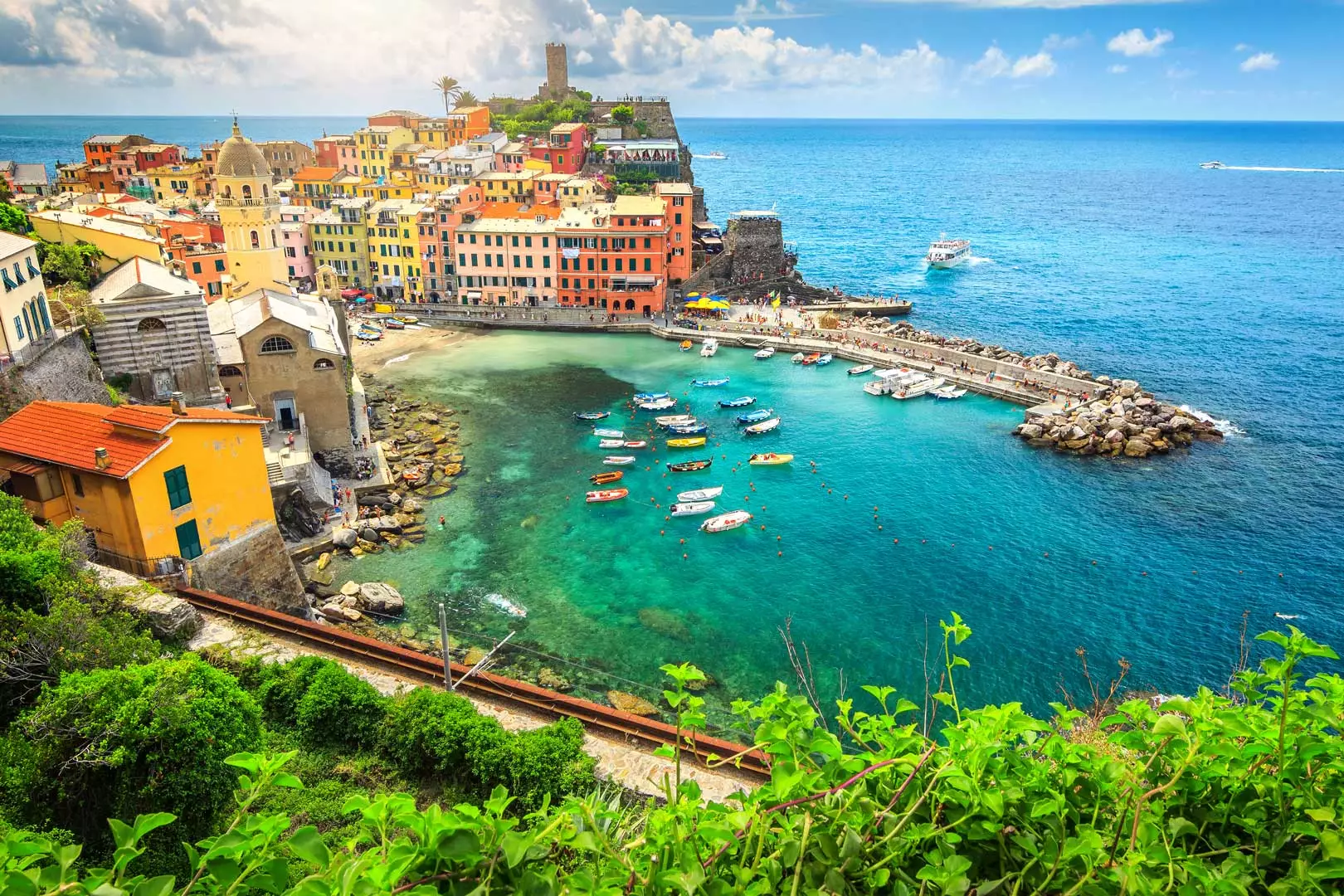
Cinque Terre, a picturesque destination on the Italian Riviera, comprises five vibrant villages: Riomaggiore, Manarola, Corniglia, Vernazza, and Monterosso al Mare. Nestled along steep cliffs, these villages are famed for their colorful houses and vineyards clinging to the rugged terrain, presenting a breathtaking view against the backdrop of the Mediterranean Sea.
A standout feature of Cinque Terre is its lack of visible modern development. The area is characterized by its terraced agricultural land, primarily vineyards, and winding footpaths. The Sentiero Azzurro, a cliffside hiking trail connecting the villages, offers stunning coastal views and is a favorite among hikers.
Each village in Cinque Terre has its unique charm. Riomaggiore, known for its historic character and wine production, and Manarola, famous for its scenic beauty, are vibrant with their colorful buildings. Corniglia, sitting atop a cliff, is the only village not directly adjacent to the sea, offering panoramic views. Vernazza, with its beautiful natural harbor, is considered one of Italy's most beautiful towns. Monterosso al Mare, the largest of the five, boasts lovely beaches and a historical old town.
Designated as a UNESCO World Heritage Site, Cinque Terre is a testament to harmonious human interaction with a challenging but spectacular natural environment. The area's emphasis on preserving its traditional fishing economy and unique landscape makes it a captivating destination for those seeking a blend of natural beauty and cultural richness.
3. Leaning Tower of Pisa
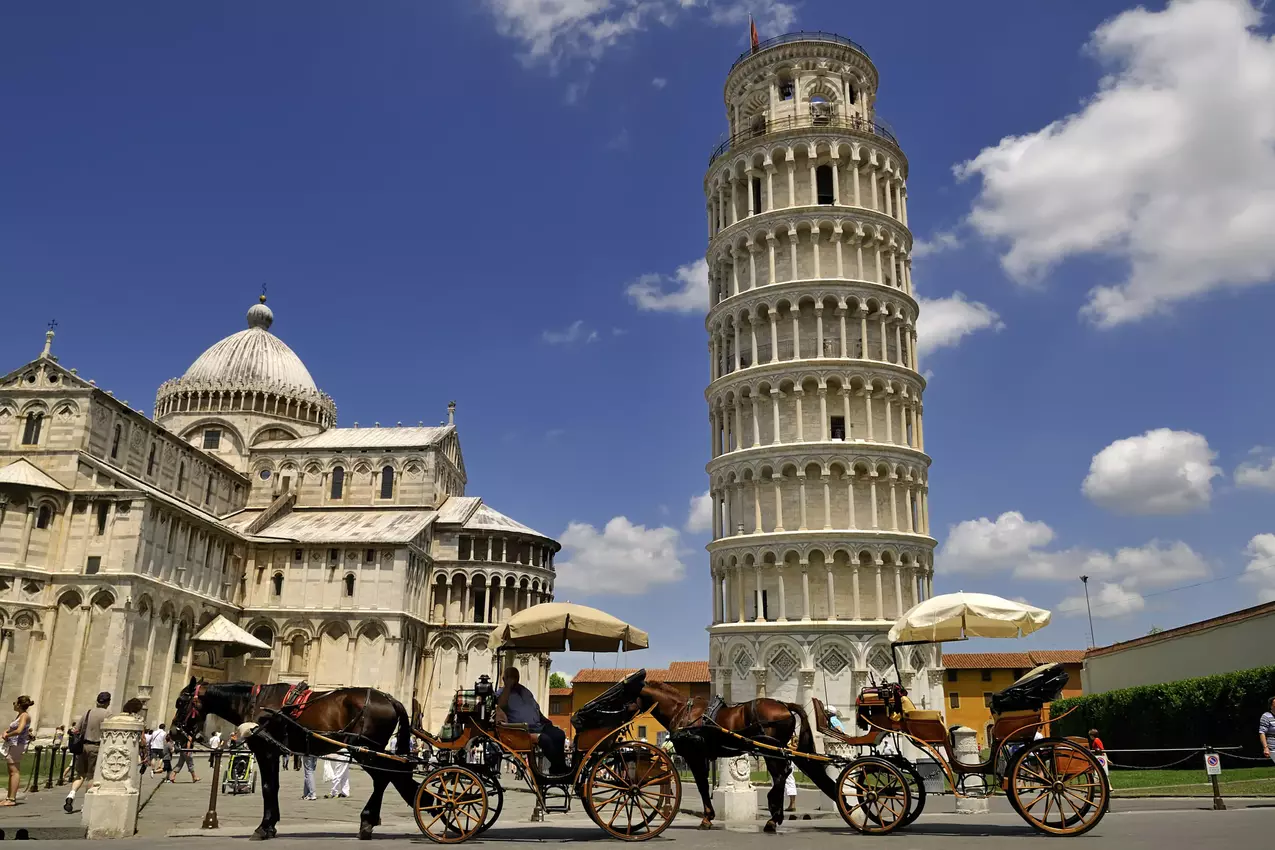
The Leaning Tower of Pisa is a world-renowned architectural anomaly and one of Italy's most famous landmarks. Located in the city of Pisa in Tuscany, this freestanding bell tower is famous for its unintended tilt, a result of an unstable foundation. The tower began to lean during its construction in the 12th century, which spanned nearly 200 years.
Standing at about 56 meters tall, the tower has eight stories, including the chamber for its seven bells. The largest bell was installed in 1655. The design of the tower, with its white and grey marble, Romanesque columns, and arches, reflects the artistic and architectural trends of medieval Italy.
Visitors can climb the 294 steps spiraling inside the tower to reach the top, where they are rewarded with panoramic views of Pisa. The tower is part of the Piazza dei Miracoli (Square of Miracles), a UNESCO World Heritage Site, which also includes the Pisa Cathedral (Duomo di Pisa), the Baptistery, and the Campo Santo, a historic cemetery.
The Leaning Tower of Pisa's tilt has been stabilized through various restoration and engineering efforts over the years, ensuring its continued safety and appeal. This architectural marvel continues to captivate millions of tourists annually, making it a must-visit Italian landmark.
4. Venice Canals and Rialto Bridge
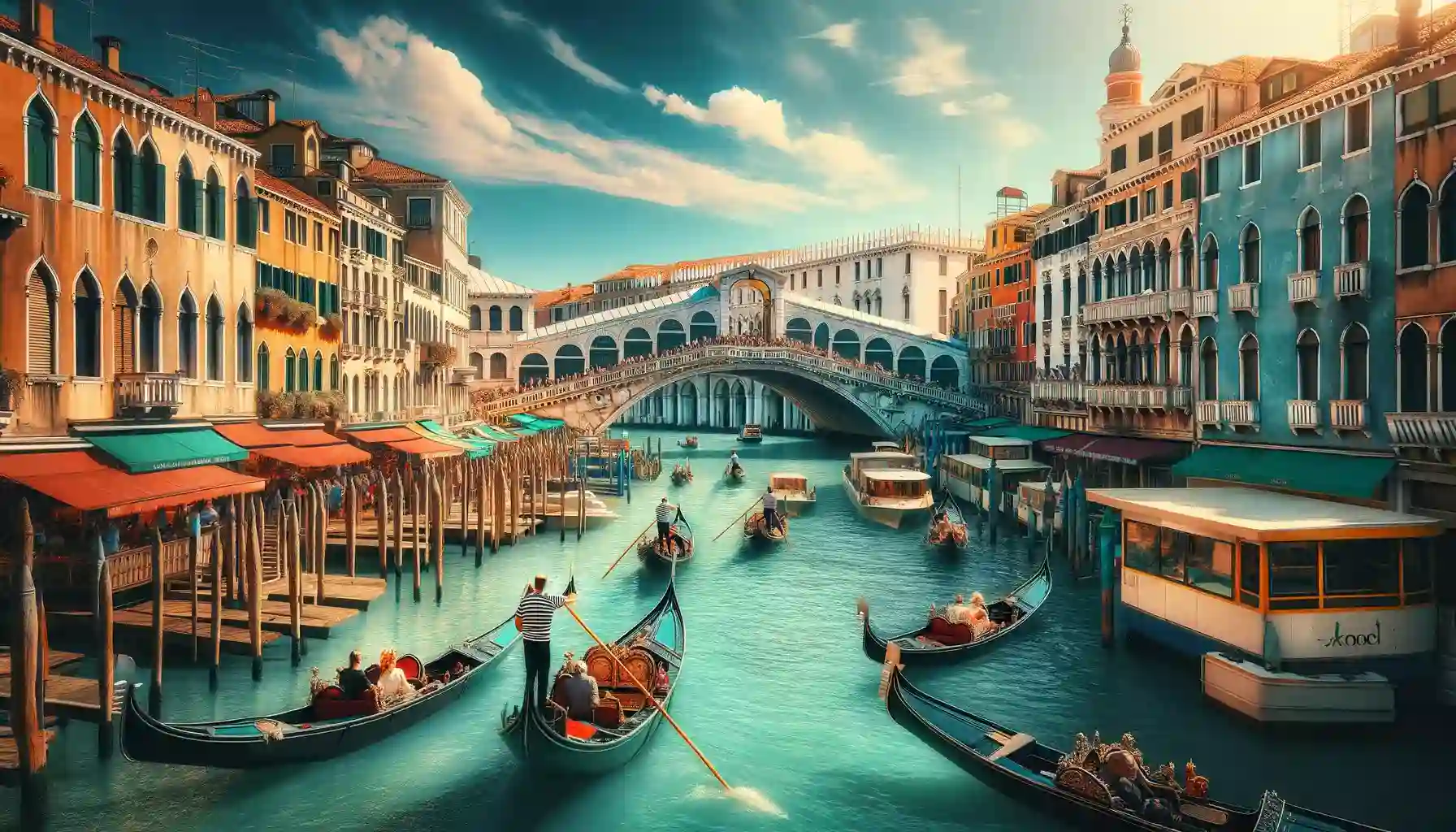
The Venice Canals are the lifeblood of this unique and enchanting city, known for its lack of roads and intricate network of waterways. At the heart of Venice’s canal system is the Grand Canal, a magnificent waterway that meanders through the city in a large S-shape. It's lined with opulent buildings that reflect Venice's historical wealth and artistic heritage, showcasing a mix of architectural styles, including Gothic, Renaissance, and Baroque.
One of the main landmarks along the Grand Canal is the Rialto Bridge (Ponte di Rialto). This iconic stone bridge, one of the oldest and most recognizable in Venice, was completed in 1591 and is an architectural marvel of the Renaissance period. Designed by Antonio da Ponte, the bridge stands on 12,000 wooden pilings and was built to replace various wooden bridges that had collapsed previously. It spans the narrowest point of the Grand Canal and was historically the only permanent passage across the canal until the 19th century.
The Rialto Bridge's design features two inclined ramps leading up to a central portico. On either side of the ramps, rows of shops add to the bridge’s bustling atmosphere, continuing a tradition that dates back to the 12th century. These shops mainly sell jewelry, linens, Murano glass, and other souvenirs, making the bridge not only a vital transportation route but also a popular shopping destination.
As you venture beyond the Grand Canal, Venice's labyrinth of smaller canals leads to numerous attractions. The city’s squares, like the iconic Piazza San Marco, and grand structures such as the Doge’s Palace, and the Bridge of Sighs are all interconnected by these waterways. Venice’s canals also guide visitors to hidden courtyards, historic churches, and splendid palaces.
Visitors often explore the canals via gondola rides or vaporettos (water buses), which provide a unique perspective of the city and its architecture. The canals are not just a means of transportation but are central to the character and history of Venice, making the city a floating masterpiece of unparalleled beauty and charm.
5. Mount Etna, Sicily
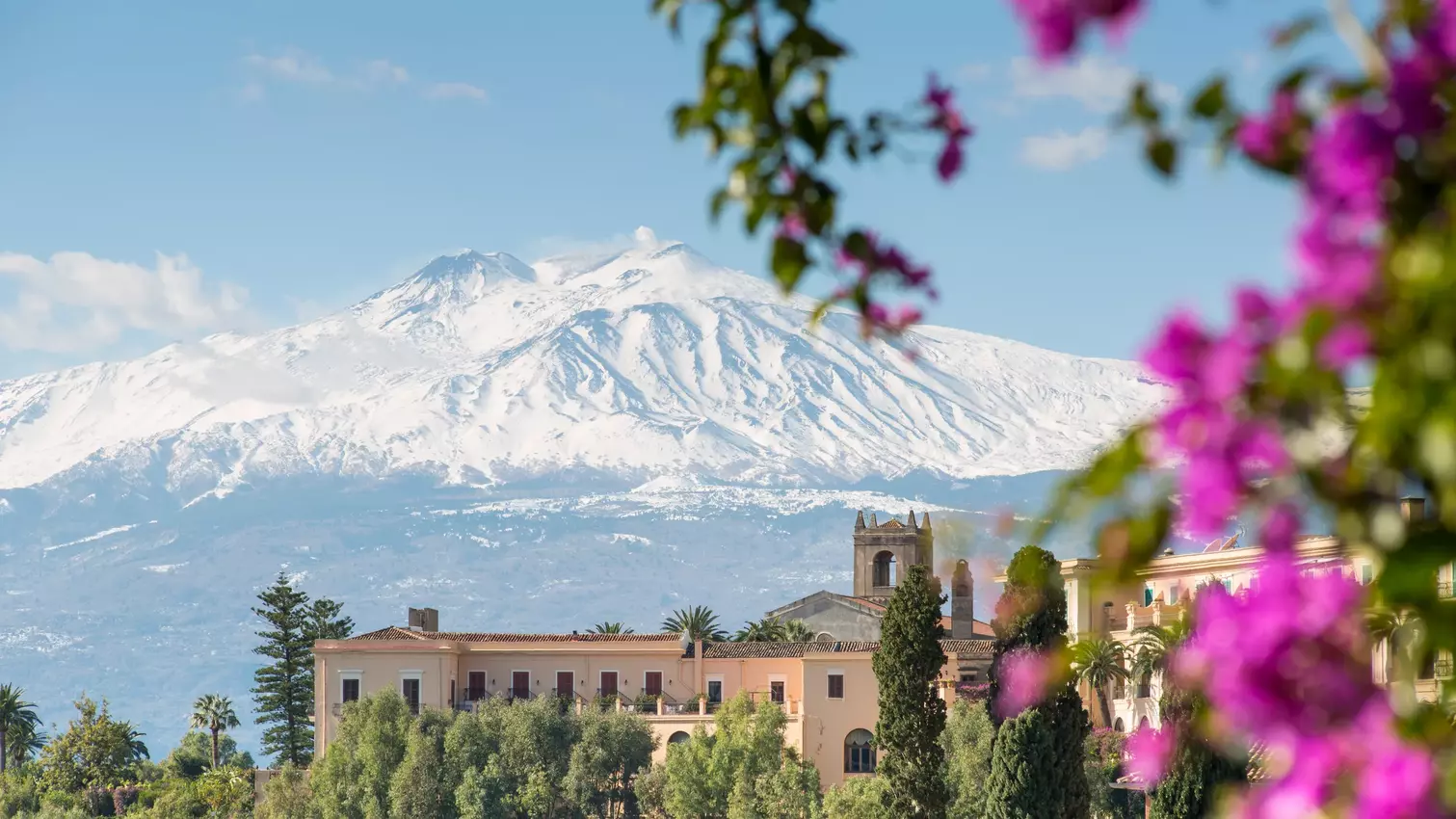
Mount Etna, located on the east coast of Sicily, is not only Europe's highest volcano but also one of its most active. Standing majestically at about 3,329 meters (10,922 feet), it is a prominent feature of the Sicilian landscape and a symbol of the island's rugged natural beauty.
Etna's frequent eruptions and lava flows have shaped its unique landscape over centuries. The volcano offers a range of activities, with hiking trails leading up its slopes, providing adventurers with an opportunity to witness the dramatic volcanic scenery up close. The Crateri Silvestri, easily accessible craters near the Rifugio Sapienza area, are a popular spot for visitors.
The Cable Car and 4x4 Tours transport visitors higher up the mountain, offering stunning views of the lunar-like landscape and, on clear days, views across the Ionian Sea. The mountain is also home to a rich variety of flora and fauna, thriving in its diverse habitats, and the surrounding Etna Regional Park is a haven for nature lovers.
For those interested in geology, the Volcanic Observatory in Catania provides insights into Etna's activity and history. In winter, the volcano transforms into a skiing destination, with the Etna Sud and Etna Nord ski resorts offering unique skiing experiences with breathtaking views.
Mount Etna's fertile volcanic soils support vineyards producing excellent wines, making wine tasting another attraction. This majestic volcano is a testament to nature's power, offering a unique blend of natural beauty, adventure, and scientific interest.
6. The Valley of the Temples, Sicily
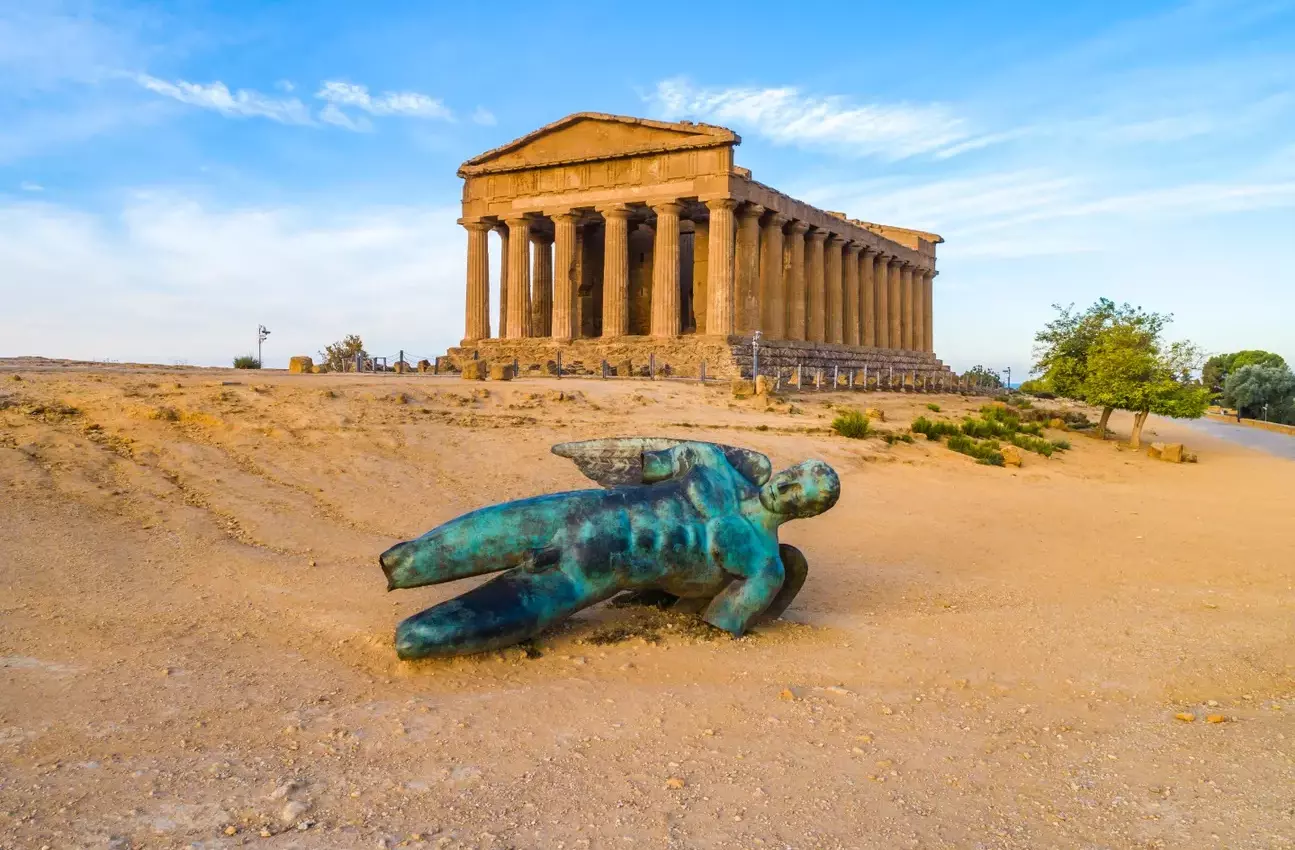
The Valley of the Temples, located near Agrigento on the southern coast of Sicily, is one of the most outstanding examples of Greater Greece's art and architecture. This UNESCO World Heritage site comprises a series of ancient Greek temples built between about 510 BC and 430 BC.
One of the most famous temples here is the Temple of Concordia, which is one of the best-preserved Doric-style temples in the world. This temple, along with the Temple of Juno and the Temple of Heracles, exemplifies the architectural mastery of the ancient Greeks.
Another significant structure is the Temple of Zeus, which, though now largely in ruins, was once one of the largest Doric temples ever constructed. The site also includes the Temple of Castor and Pollux, identifiable by its four iconic columns.
Apart from these, the Archaeological Museum at the site houses a vast collection of artifacts, providing deeper insights into the history and culture of ancient Agrigento.
The Valley of the Temples is not just an archaeological site; it's a scenic landscape filled with almond and olive trees, offering a picturesque backdrop to these ancient wonders. The site's unique blend of cultural history and natural beauty makes it a must-visit for those interested in ancient civilizations and Mediterranean scenery.
7. Lake Como
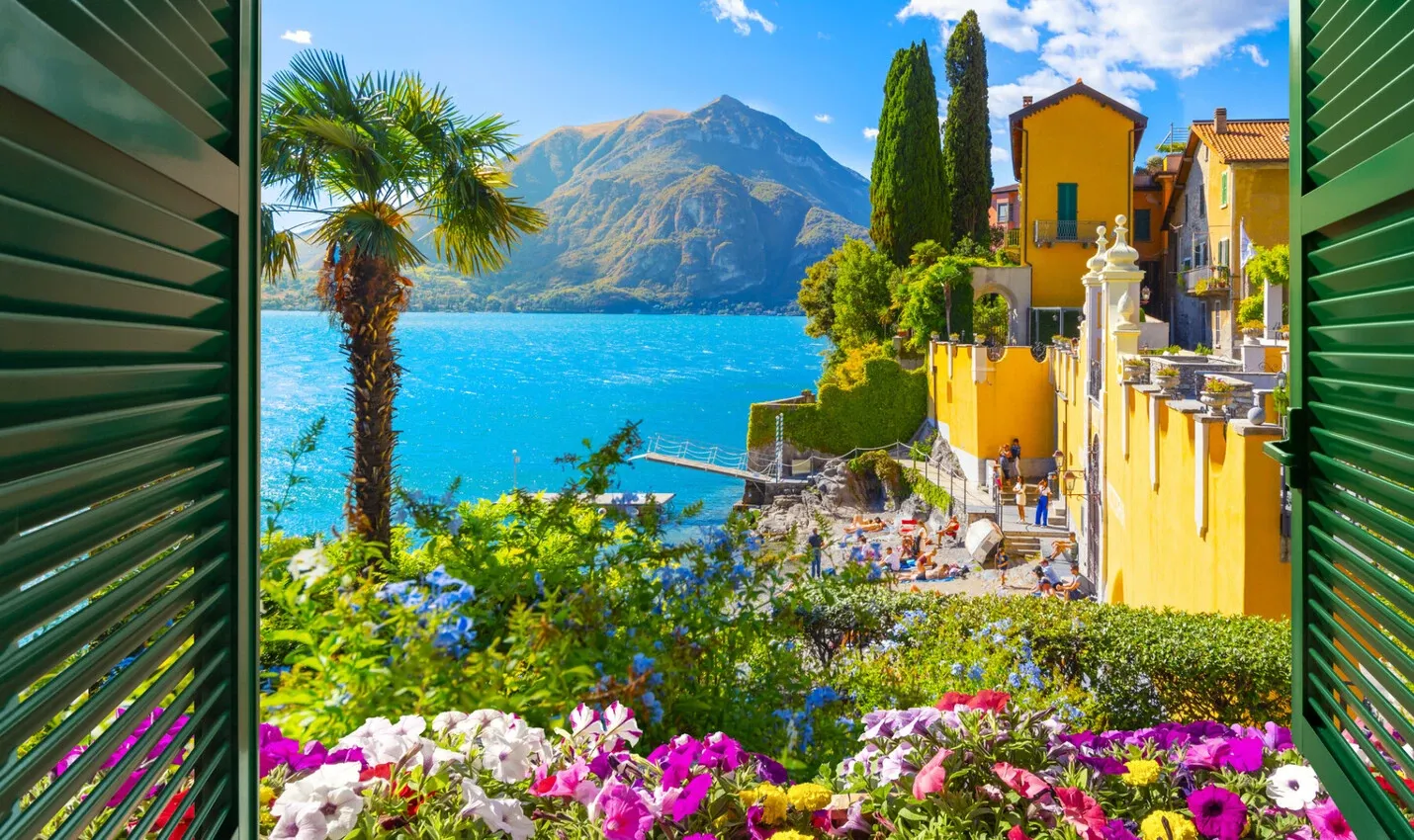
Lake Como, nestled in the Lombardy region of Italy, is renowned for its extraordinary natural beauty and luxurious resorts. This Y-shaped lake, surrounded by lush hills and mountains, has been a popular retreat for aristocrats and the wealthy since Roman times, and it continues to attract celebrities and travelers seeking tranquility and splendor.
The lake is known for its deep blue waters and the stunning Villas that dot its shores, including the Villa Carlotta and Villa del Balbianello, both famed for their exquisite gardens and historical significance. The charming towns around Lake Como, such as Bellagio, Varenna, and Menaggio, offer picturesque streets, elegant buildings, and lovely waterfront promenades.
Boat tours on the lake are a popular way to enjoy the scenery and explore the various towns and villas. These towns also provide opportunities for fine dining and shopping, with local boutiques and artisan shops offering unique Italian goods.
Outdoor enthusiasts can enjoy activities like hiking in the surrounding hills, offering panoramic views of the lake and the Alps. Cycling and water sports such as sailing, windsurfing, and kitesurfing are also popular.
Lake Como's combination of natural beauty, historical charm, and modern luxury make it a quintessential Italian destination, perfect for relaxation and exploration.
8. Pompeii
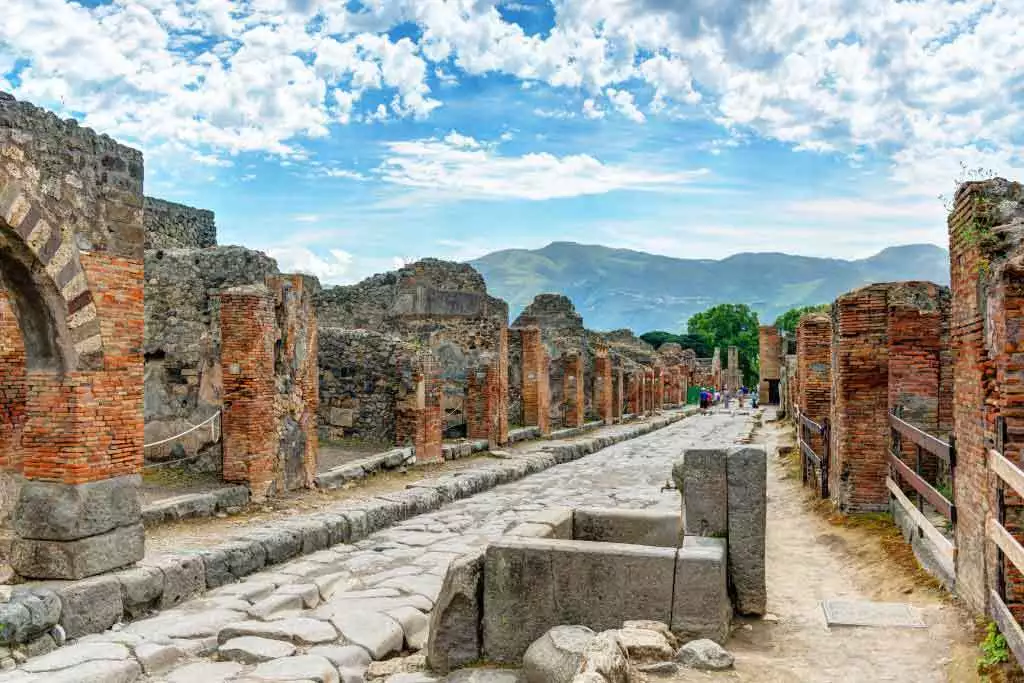
Pompeii is an ancient Roman city frozen in time due to the catastrophic eruption of Mount Vesuvius in 79 AD. This UNESCO World Heritage site near Naples offers an unparalleled glimpse into ancient Roman life, as the city was buried under volcanic ash, preserving it for centuries.
Visitors to Pompeii can walk along the ancient streets and see the remains of homes, shops, and public buildings. Notable structures include the Forum, the Amphitheater, and the Temple of Apollo, each echoing the city's former grandeur. The House of the Vettii and the House of the Faun are famous for their well-preserved frescoes and intricate mosaics.
Pompeii is also known for the casts of victims, which are poignant reminders of the eruption's human toll. These casts were created by pouring plaster into voids left by decomposed bodies, capturing the final moments of the residents.
The Lupanar of Pompeii, an ancient brothel, is another intriguing site, notable for its erotic frescoes. Additionally, the Villa of the Mysteries just outside Pompeii is famous for its well-preserved frescoes depicting Dionysian mysteries.
A visit to Pompeii is not just a tour of an archaeological site; it's an immersive experience of an ancient world, offering a unique and profound understanding of Roman civilization.
9. Amalfi Coast
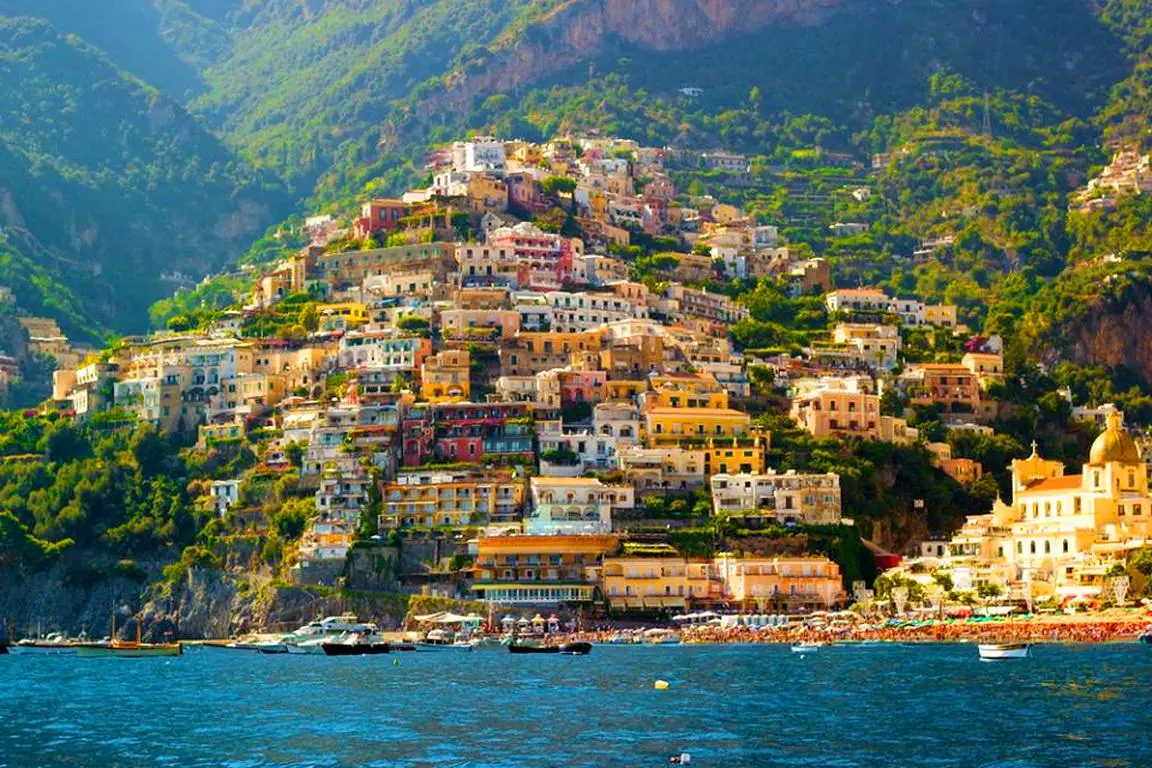
The Amalfi Coast in southern Italy is celebrated for its extraordinary beauty and iconic Mediterranean landscape. This stunning stretch of coastline along the Sorrentine Peninsula is characterized by steep cliffs, crystal-clear waters, and a string of picturesque towns, each with its own unique allure.
Key attractions include the town of Positano, with its pastel-colored houses cascading down to the sea, and Amalfi, the coast’s namesake, known for its beautiful cathedral and bustling piazzas. Ravello, perched high above the coast, offers breathtaking views and is home to the famous Villa Rufolo and Villa Cimbrone, both renowned for their stunning gardens and panoramic vistas.
The area is a paradise for hikers, with paths like the Path of the Gods (Sentiero degli Dei) providing some of the most scenic hiking in Italy. The coastline is also dotted with secluded coves and beaches, such as Fiordo di Furore and Marina Grande Beach, perfect for swimming and sunbathing.
The Amalfi Coast is not only about natural beauty; it’s also rich in history and culture. The Emerald Grotto (Grotta dello Smeraldo) in Conca dei Marini and the historic paper mills of Amalfi offer insights into the region's unique heritage.
With its combination of natural splendors, historical sites, and charming towns, the Amalfi Coast epitomizes the quintessential Italian coastal experience.
10. Capri
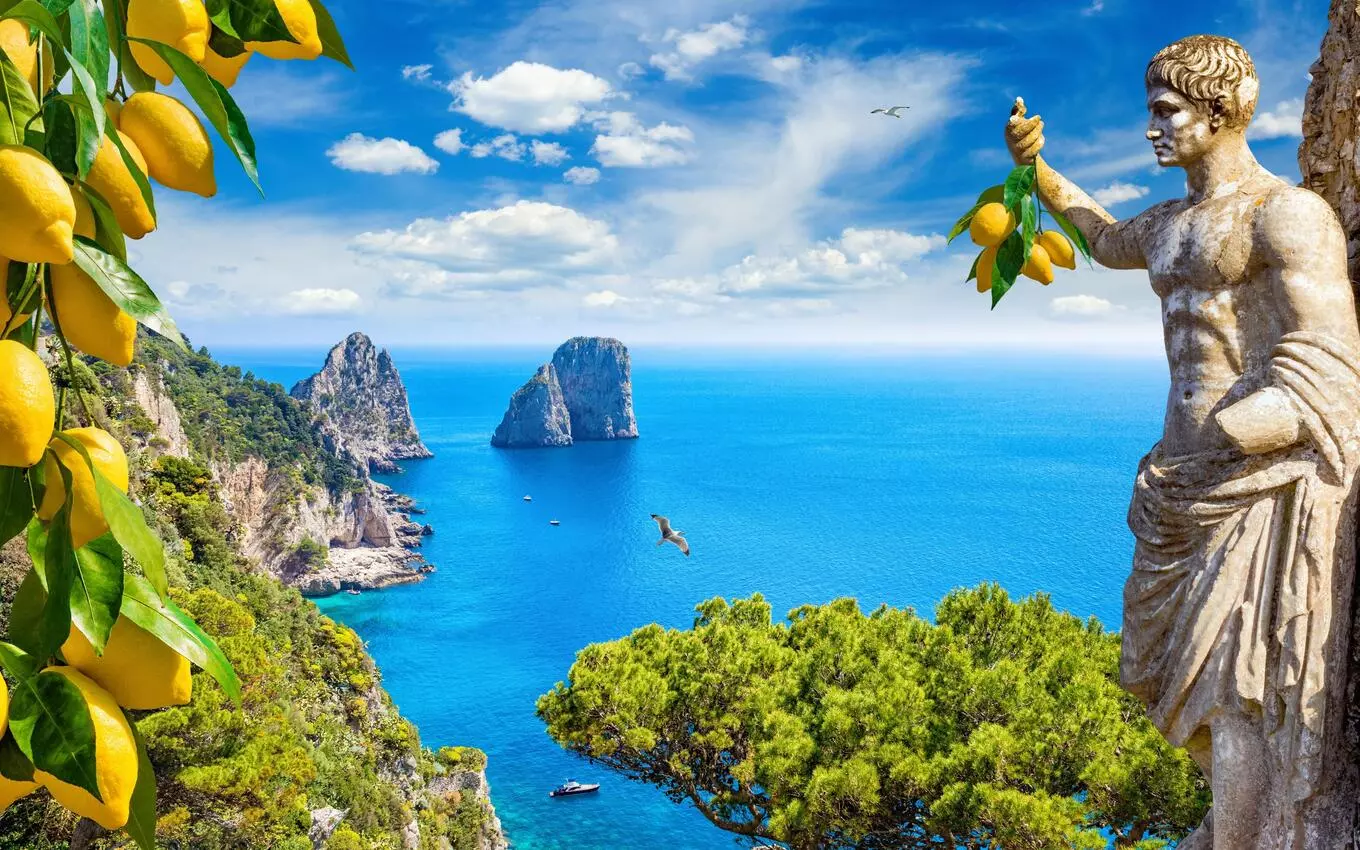
Capri is an enchanting Italian island in the Bay of Naples, celebrated for its rugged landscape, luxury accommodations, and upscale shopping. This island is a blend of natural beauty, history, and modern glamour, attracting visitors with its stunning cliffs, hidden coves, and vibrant lifestyle.
A must-visit attraction is the Blue Grotto (Grotta Azzurra), a magical sea cave where the water glows electric blue due to the sunlight passing through an underwater cavity. Villa San Michele in Anacapri offers spectacular views and beautiful gardens, while the Augustus Gardens provide a panoramic overlook of the famous Faraglioni rocks, iconic symbols of Capri.
Capri's main town, also named Capri, is known for its designer boutiques, selling high fashion, handmade leather sandals, and the island's signature lemon liqueur, limoncello. Anacapri, the quieter of the two towns, offers a more laid-back atmosphere and charming historic sites.
For a dramatic view of the island and the sea, visitors can take a chairlift to Monte Solaro, the highest point on Capri. The island is also rich in history, with Roman ruins like Villa Jovis, the former residence of Emperor Tiberius, highlighting its ancient past.
Capri is not just a destination; it's an experience of natural wonders, luxurious indulgence, and a vibrant Italian culture.
11. Royal Palace of Caserta
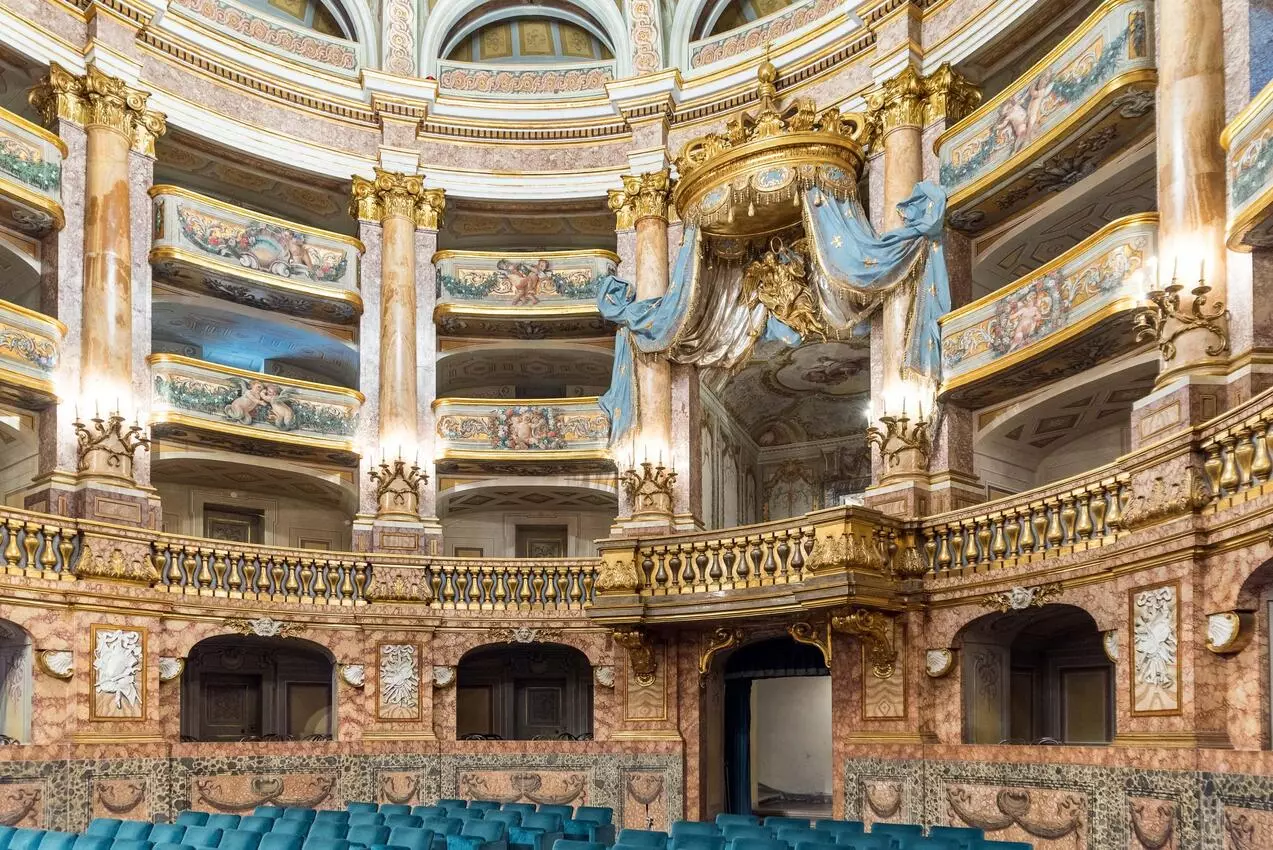
The Royal Palace of Caserta, located in the Campania region of Italy, is a magnificent example of Italian Baroque architecture. Constructed in the 18th century for the Bourbon kings of Naples, it is one of the largest royal residences in the world.
This grandiose palace, designed by architect Luigi Vanvitelli, impresses with its sheer size and elaborate design. The palace features 1,200 rooms, including the opulent Throne Room and the sumptuously decorated Royal Apartments, showcasing the luxurious lifestyle of the Bourbon monarchy.
One of the palace’s most renowned features is its vast and intricate park and gardens. Stretching over 120 hectares, the park is adorned with beautiful fountains, such as the Diana and Actaeon Fountain and the Great Waterfall, and the stunning English Garden, rich in exotic plants and ancient sculptures.
The palace also houses the Palatine Library and the Royal Silk Factory, which testify to the cultural and economic pursuits of the Bourbon kings. The Astronomical Observatory, a testament to the scientific interests of the era, is another attraction within the palace complex.
Declared a UNESCO World Heritage Site, the Royal Palace of Caserta is not only an architectural masterpiece but also a symbol of the grandeur and history of the Kingdom of Naples.
12. The Pantheon, Rome

The Pantheon in Rome, an architectural marvel of the ancient world, is renowned for its perfectly proportioned dome and enduring grandeur. Originally built as a temple to all Roman gods, it was reconstructed by Emperor Hadrian around 126 AD. The Pantheon's design has influenced Western architectural styles for centuries.
The building's most striking feature is its massive dome, the largest unreinforced concrete dome in the world. The dome's interior coffering and the central oculus, an open hole at the dome's apex, are not only essential for structural purposes but also create a unique interplay of light within the interior.
The Pantheon's portico, with its Corinthian columns and triangular pediment, leads to the grand rotunda, an immense circular space that has astounded visitors for centuries. The building's harmonious proportions, where the diameter of the interior circle equals the height of the dome, create a sense of balance and beauty.
Inside, the Pantheon also serves as a final resting place for notable figures, including the Renaissance artist Raphael and Italian kings Vittorio Emanuele II and Umberto I.
Today, the Pantheon remains an active church and a prime example of Roman engineering genius, making it a must-visit landmark for those interested in history, architecture, and the enduring legacy of ancient Rome.
13. Vatican City
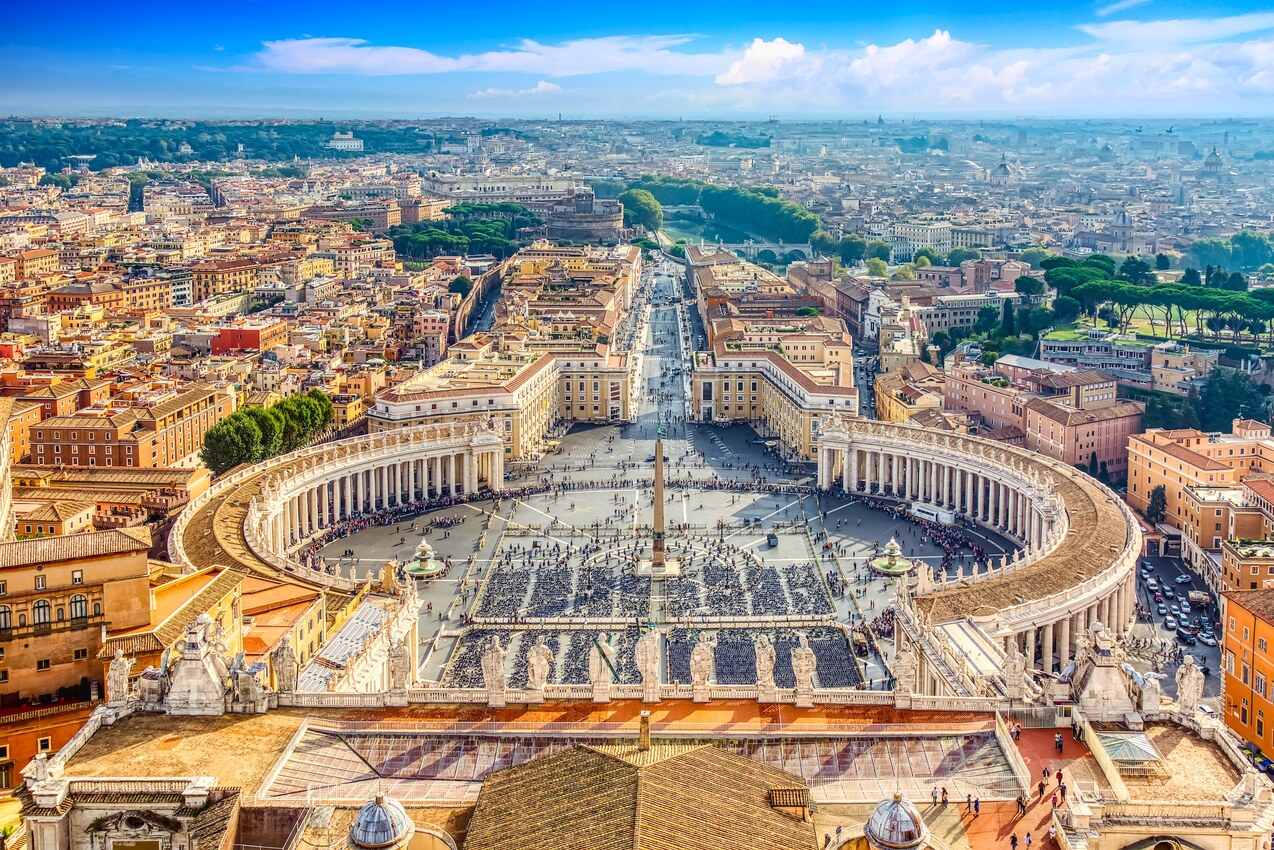
Vatican City, the smallest independent state in the world, is the spiritual and administrative center of the Roman Catholic Church. This city-state, enclaved within Rome, is a treasure trove of artistic and religious significance.
The heart of Vatican City is St. Peter's Basilica, one of the largest and most important churches in Christianity. The basilica is renowned for its stunning Renaissance architecture, designed by masters like Bramante, Michelangelo, and Bernini. Inside, visitors can admire Michelangelo's Pieta and the magnificent Baldachin over the altar by Bernini.
Adjacent to the basilica is the iconic St. Peter's Square, designed by Bernini, known for its colossal Doric colonnades and central obelisk. This square hosts Papal audiences and is a gathering place for pilgrims.
Another key attraction is the Sistine Chapel, famous for Michelangelo's breathtaking ceiling frescoes, including the Creation of Adam and the Last Judgment. The Sistine Chapel is also where the Papal conclave takes place for the election of new Popes.
The Vatican Museums house an extensive collection of art and historical artifacts, including the Raphael Rooms and the Gallery of Maps. The museums offer a journey through centuries of art and culture, making Vatican City a must-visit for art enthusiasts and religious pilgrims alike.
14. Roman Forum, Rome
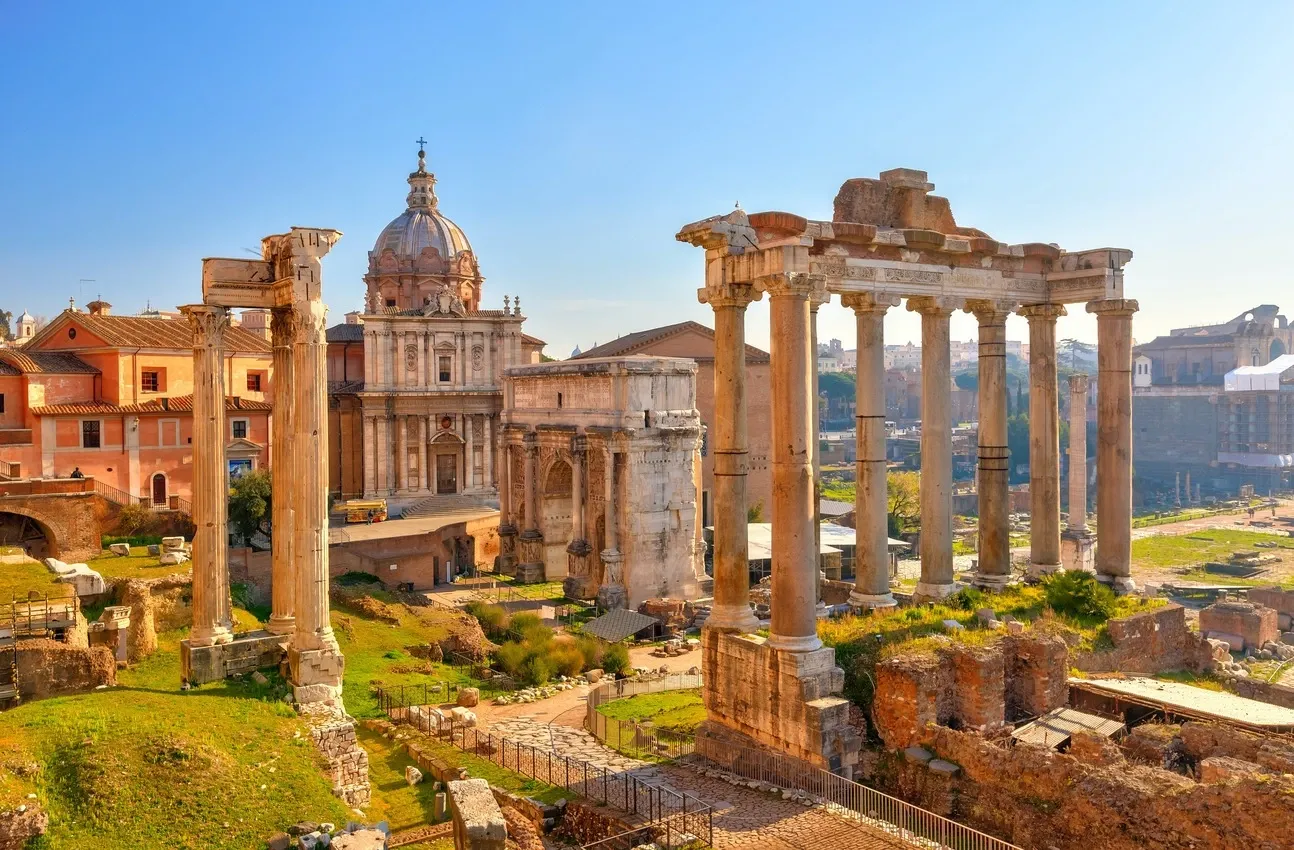
The Roman Forum, located in the heart of Rome, is a sprawling complex of architectural ruins, once the epicenter of ancient Roman public life. This site was the nucleus of Roman politics, religion, and social activities, hosting triumphal processions, elections, public speeches, and criminal trials.
Among the Forum's notable attractions are the Temple of Saturn, one of the oldest Roman temples, and the Temple of Vesta, where the sacred fire of Rome was kept burning by the Vestal Virgins. The Arch of Titus, erected to commemorate Titus' victories, including the Siege of Jerusalem, is another significant monument here.
Visitors can also see the remains of the Basilica of Maxentius and Constantine, one of the largest buildings in the Forum, and the Curia Julia, the Senate House, where Roman senators convened. The Via Sacra, the main street of ancient Rome, runs through the Forum, leading to the Colosseum.
The Rostra, the platform for orators, and the Tabularium, housing the official records, are other highlights, showcasing the Forum's role in administration and governance.
Exploring the Roman Forum is like walking through a living museum, offering a deep insight into the life and history of ancient Rome. This site remains a testament to the architectural and cultural prowess of the Roman Empire.
15. Trevi Fountain, Rome
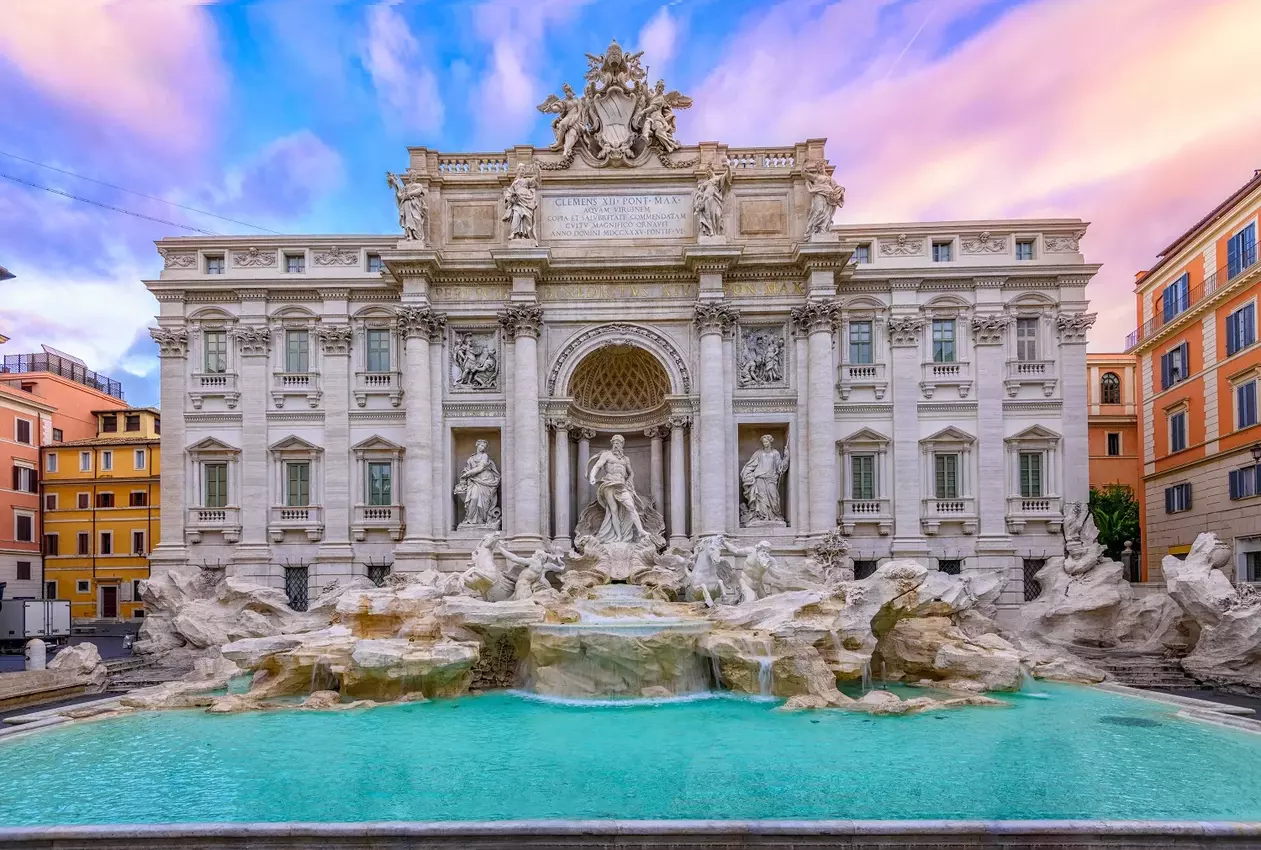
The Trevi Fountain, situated in the heart of Rome, is the city's largest and most celebrated Baroque fountain. This stunning masterpiece, completed in 1762, was designed by Nicola Salvi and stands as a symbol of Rome's rich artistic heritage.
Dominating the fountain is the majestic figure of Oceanus, the god of water, riding a chariot in the shape of a shell and pulled by sea horses guided by Tritons. The fountain's design depicts the sea god commanding the waters, with sculptures of Abundance and Health flanking him.
The Trevi Fountain is not just a marvel of Baroque artistry but also a cultural icon, immortalized in films and literature. It's famous for the tradition of tossing coins into the water; one coin ensures a return to Rome, two coins lead to a new romance, and three coins lead to marriage.
Nestled in a small piazza, the fountain is surrounded by buildings that create a stunning backdrop, enhancing its visual impact. The sound of its cascading waters and the intricate detailing of its sculptures make the Trevi Fountain a sensory delight.
This monumental fountain is more than just a tourist attraction; it's a testament to Rome's enduring legacy as a center of art and beauty, drawing visitors from around the world who come to marvel at its grandeur and partake in its traditions.
16. The Spanish Steps, Rome
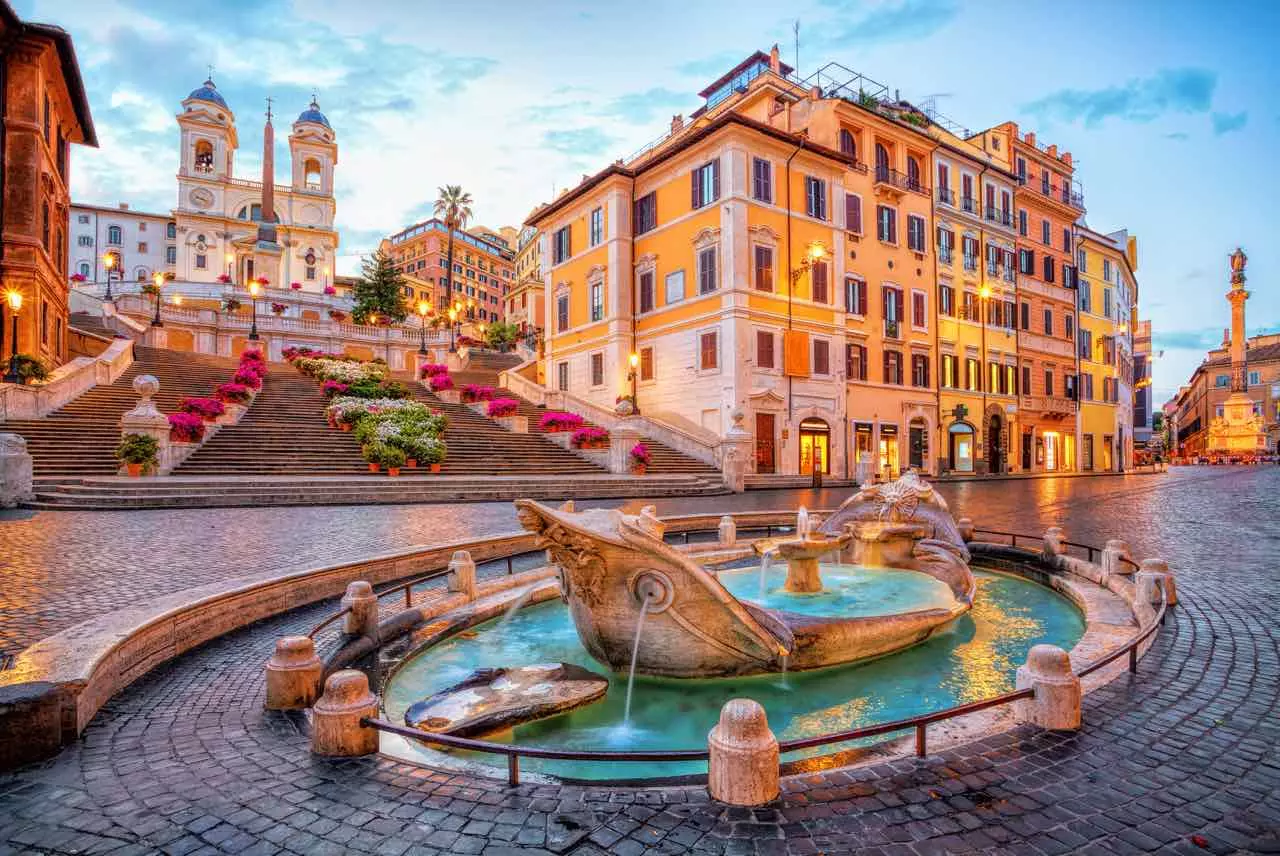
The Spanish Steps in Rome are a monumental stairway of 135 steps, famed for their elegant design and as a popular gathering place. Built-in the 18th century, they connect the Piazza di Spagna at the base with the Piazza Trinità dei Monti and the church of the same name at the top.
Architect Francesco de Sanctis designed the steps in a mix of straight flights, curves, and terraces, creating a unique architectural harmony that has attracted visitors for centuries. The steps are framed by vibrant azaleas in spring, adding to their beauty.
At the foot of the Spanish Steps is the Fontana della Barcaccia, a Baroque fountain designed by Pietro Bernini and his son Gian Lorenzo Bernini. The fountain, resembling a sinking ship, adds to the allure of the Piazza di Spagna.
The steps have been a meeting place and a cultural hotspot, famously associated with poets, artists, and the glamorous Roman lifestyle. The nearby streets like Via dei Condotti are renowned for high-end shopping, offering luxury Italian and international fashion brands.
The Spanish Steps, with their blend of architectural beauty, cultural significance, and vibrant urban atmosphere, remain one of Rome's most iconic attractions, offering a picturesque spot for relaxation and people-watching in the heart of the city.
17. Ostia Antica, Rome
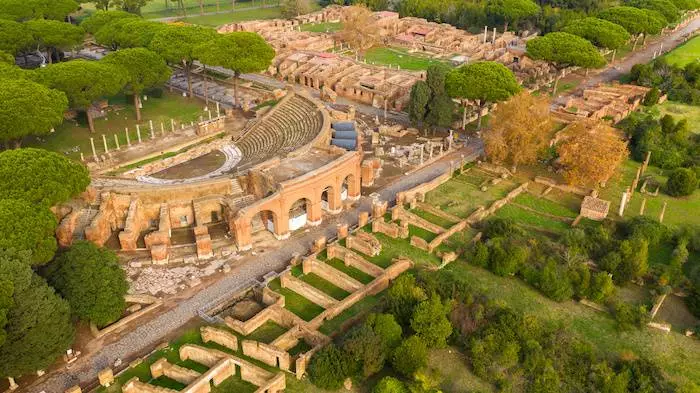
Ostia Antica, once the bustling seaport of ancient Rome, is now a well-preserved archaeological site, offering a glimpse into the daily life of the Romans. Located at the mouth of the River Tiber, this ancient city served as Rome's primary naval base and a hub of commercial activity.
Visitors to Ostia Antica can explore the remnants of the city's grid-like streets, lined with the ruins of ancient houses, shops, and public buildings. Notable attractions include the Theatre of Ostia, which could seat up to 3,500 spectators, and the Forum, the city's main public square.
One of the most fascinating aspects of Ostia Antica is the well-preserved Mosaics and Frescoes, found in the remains of baths and houses, illustrating the artistry and daily life of the period. The Thermopolium, an ancient Roman snack bar, and the House of Diana, a well-preserved apartment building, offer insights into the domestic architecture of the time.
The site also boasts the Temple of Hercules, one of the oldest worship sites in the city, and the Square of the Guilds (Piazzale delle Corporazioni), which showcases the various trades and professions of ancient Rome.
Ostia Antica, less crowded than other archaeological sites in Italy, provides a serene and educational experience, transporting visitors back to the days of ancient Rome.
18. The Mausoleum of Hadrian, Rome
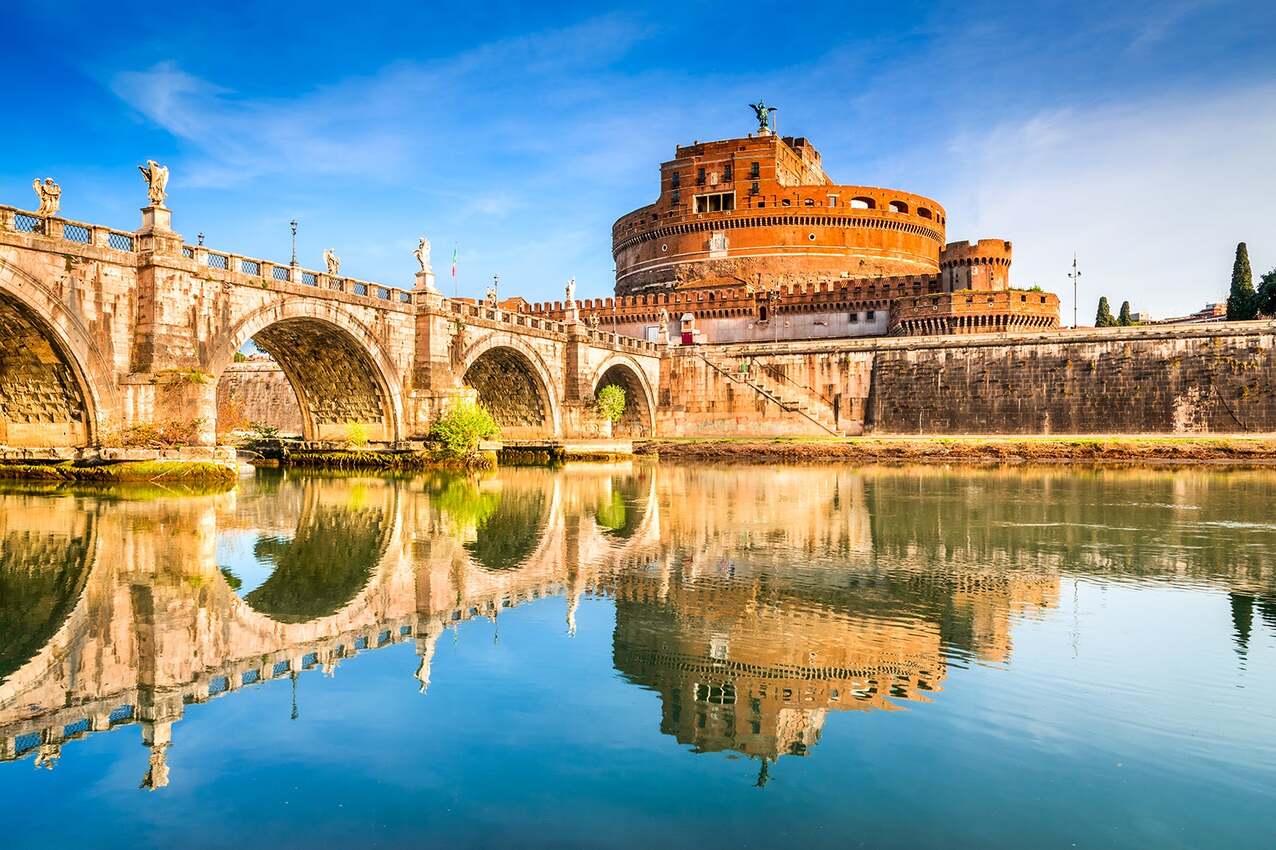
The Mausoleum of Hadrian, also known as Castel Sant'Angelo, is a towering cylindrical building in Parco Adriano, Rome. Originally commissioned by Emperor Hadrian as a mausoleum for himself and his family, the structure was later used by the popes as a fortress and castle and now serves as a museum.
Built between AD 134 and 139, the mausoleum was once the tallest building in Rome. Its design was inspired by the Mausoleum of Augustus and was adorned with a garden top and golden quadrant. Over the centuries, it has undergone various transformations, particularly during the medieval period when it was converted into a fortress.
Visitors can explore the National Museum of Castel Sant'Angelo, which houses a collection of art, historical artifacts, and Renaissance furnishings. The Papal Apartments and the Hall of the Urns, which held the ashes of Hadrian and his family, are among the key attractions.
The castle is linked to the Vatican City through the fortified corridor Passetto di Borgo. The Terrace of the Angel offers panoramic views of Rome and is named after the statue of Archangel Michael, which adorns the top, symbolizing the end of the plague of 590.
The Mausoleum of Hadrian is a testament to the architectural and historical evolution of Rome, from its initial purpose as an imperial tomb to its role as a papal fortress.
19. Florence Duomo Santa Maria del Fiore
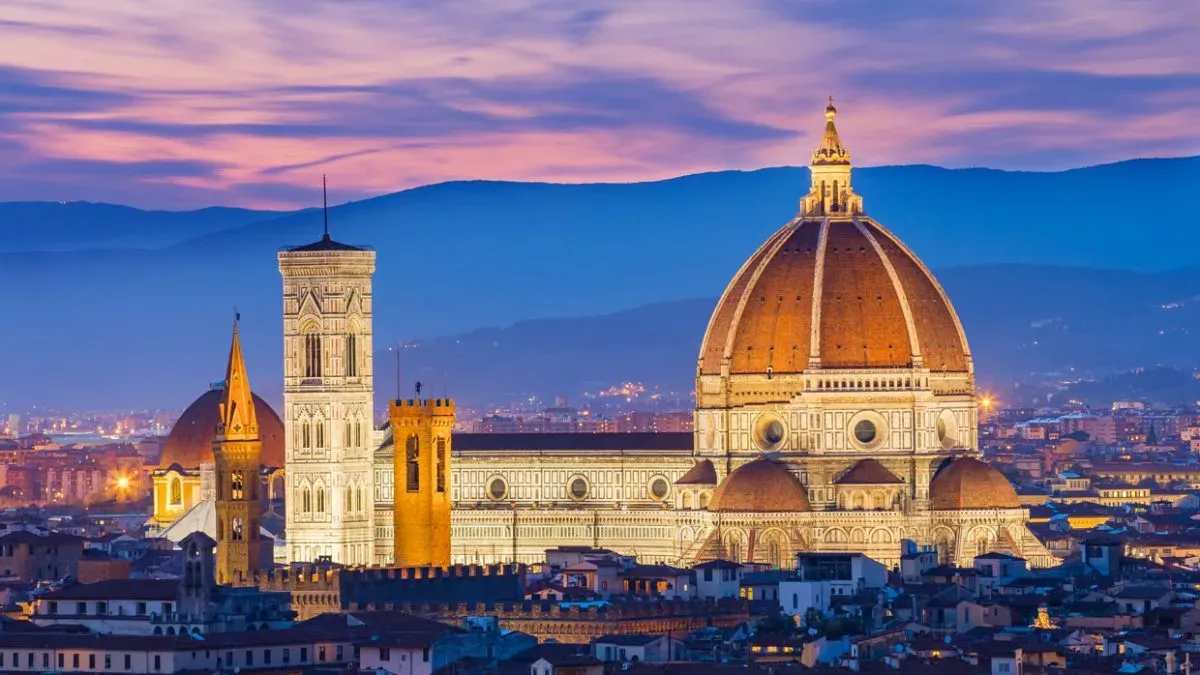
The Florence Duomo, officially known as the Cathedral of Santa Maria del Fiore, stands as a masterpiece of Italian Renaissance architecture in the heart of Florence. Designed by Arnolfo di Cambio, the cathedral is famed for its distinctive red-tiled dome, engineered by Filippo Brunelleschi, a feat of architectural genius that dominates the Florence skyline.
The Duomo's facade is a stunning combination of pink, white, and green marble, featuring intricate designs and sculptures. Inside, the cathedral's vast interior impresses visitors, though it is deliberately stark compared to its ornate exterior. The highlight is Brunelleschi's Dome, which can be climbed for panoramic views of Florence.
Adjacent to the cathedral is the Baptistery of St. John, renowned for its bronze doors with relief sculptures, including the famous Gates of Paradise by Lorenzo Ghiberti. The Campanile, or bell tower, designed by Giotto, stands close by, offering another vantage point with a series of terraces that visitors can ascend.
The Museo dell'Opera del Duomo, located nearby, houses many original works of art created for the cathedral, including masterpieces by Michelangelo and Donatello.
The Florence Duomo is not just a religious structure but a symbol of the artistic and cultural achievements of the Renaissance, attracting millions of visitors with its architectural magnificence and historical significance.
20. The Uffizi Gallery, Florence
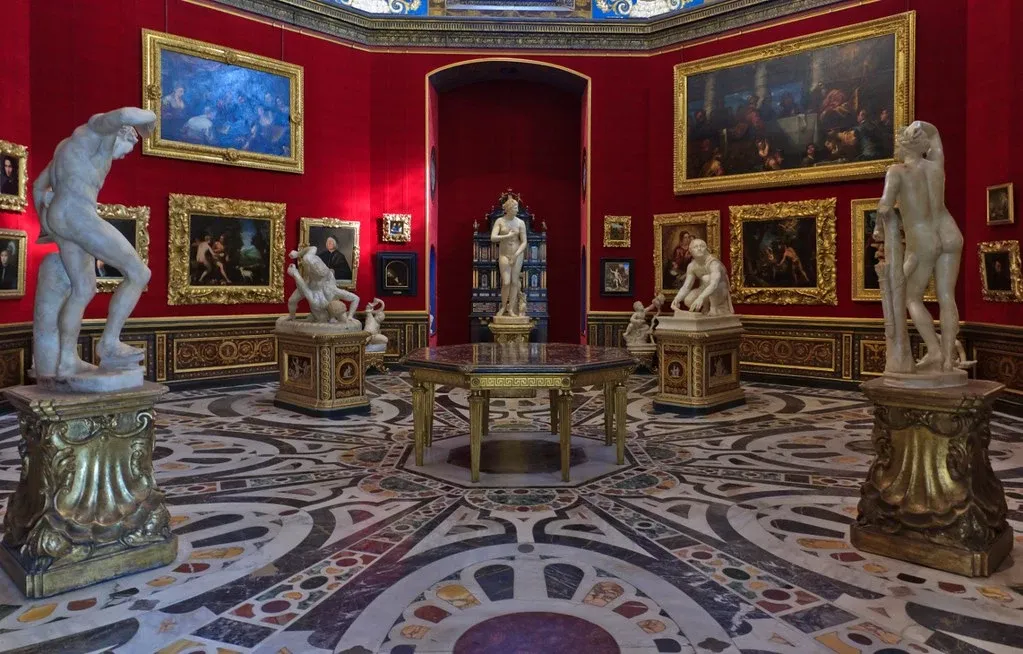
The Uffizi Gallery in Florence is one of the most renowned art museums globally, famed for its extensive collection of priceless works from the Italian Renaissance. Housed in a 16th-century building designed by Giorgio Vasari, the gallery's corridors and rooms overflow with masterpieces.
The Uffizi's collection includes some of the most significant works of the Renaissance, including Botticelli's "The Birth of Venus" and "Primavera", which are among the gallery's highlights. The museum also boasts works by other masters such as Leonardo da Vinci, Michelangelo, Caravaggio, and Raphael.
One of the gallery's key attractions is its Vasari Corridor, an elevated enclosed passageway that connects the Uffizi to the Palazzo Vecchio and the Palazzo Pitti. This corridor houses a unique collection of self-portraits by prominent artists.
Additionally, the gallery's Niobe Room and the Tribuna are adorned with classical sculptures and intricate decorations, adding to the overall experience.
The Uffizi Gallery is more than just a museum; it's a journey through the history of Renaissance art, offering a window into the artistic and cultural flowering that took place in Florence and influenced the entire world. The gallery's vast collection and the historical significance of its artworks make it a must-visit destination for art lovers and history enthusiasts alike.
21. Siena’s Historic Center
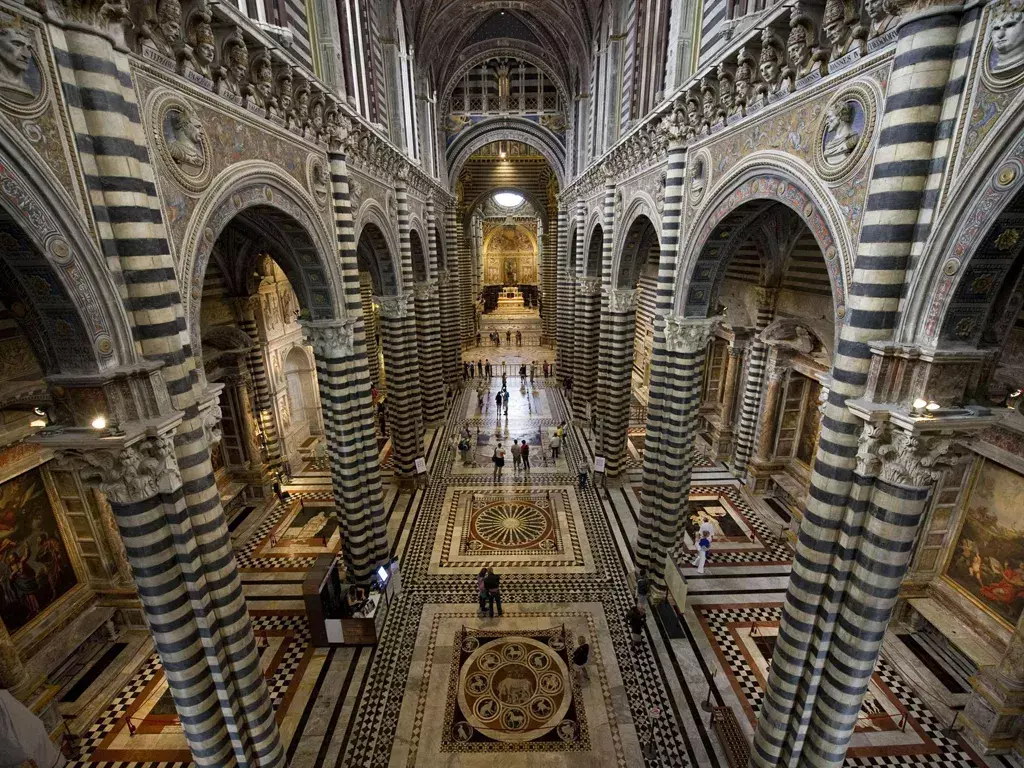
Siena's Historic Center in Tuscany is a remarkably well-preserved medieval city, renowned for its beautiful historic buildings and the vibrant Palio horse race. The city's unique fan-shaped central square, Piazza del Campo, is regarded as one of Europe's greatest medieval squares.
Piazza del Campo is the heart of Siena and the site of the famous Palio, a traditional horse race held twice a year, where the city's districts compete in a vibrant and competitive atmosphere. The square's gentle slope and fan-like layout offer a natural amphitheater setting for this and other public events.
Surrounding the square are notable structures like the Palazzo Pubblico, Siena's town hall, featuring the Torre del Mangia, a tall and slender bell tower that visitors can climb for stunning views of the city. The building also houses the Civic Museum, home to important Sienese artworks.
Another major attraction is the Siena Cathedral (Duomo di Siena), a masterpiece of Italian Gothic architecture, with its exquisite facade and interior adorned with works by Donatello, Michelangelo, and Bernini.
Siena's historic center, with its narrow winding streets and medieval architecture, offers a journey back in time. This UNESCO World Heritage site embodies the essence of medieval Italy and remains a testament to the city's rich history and cultural legacy.
22. Val d'Orcia, Tuscany
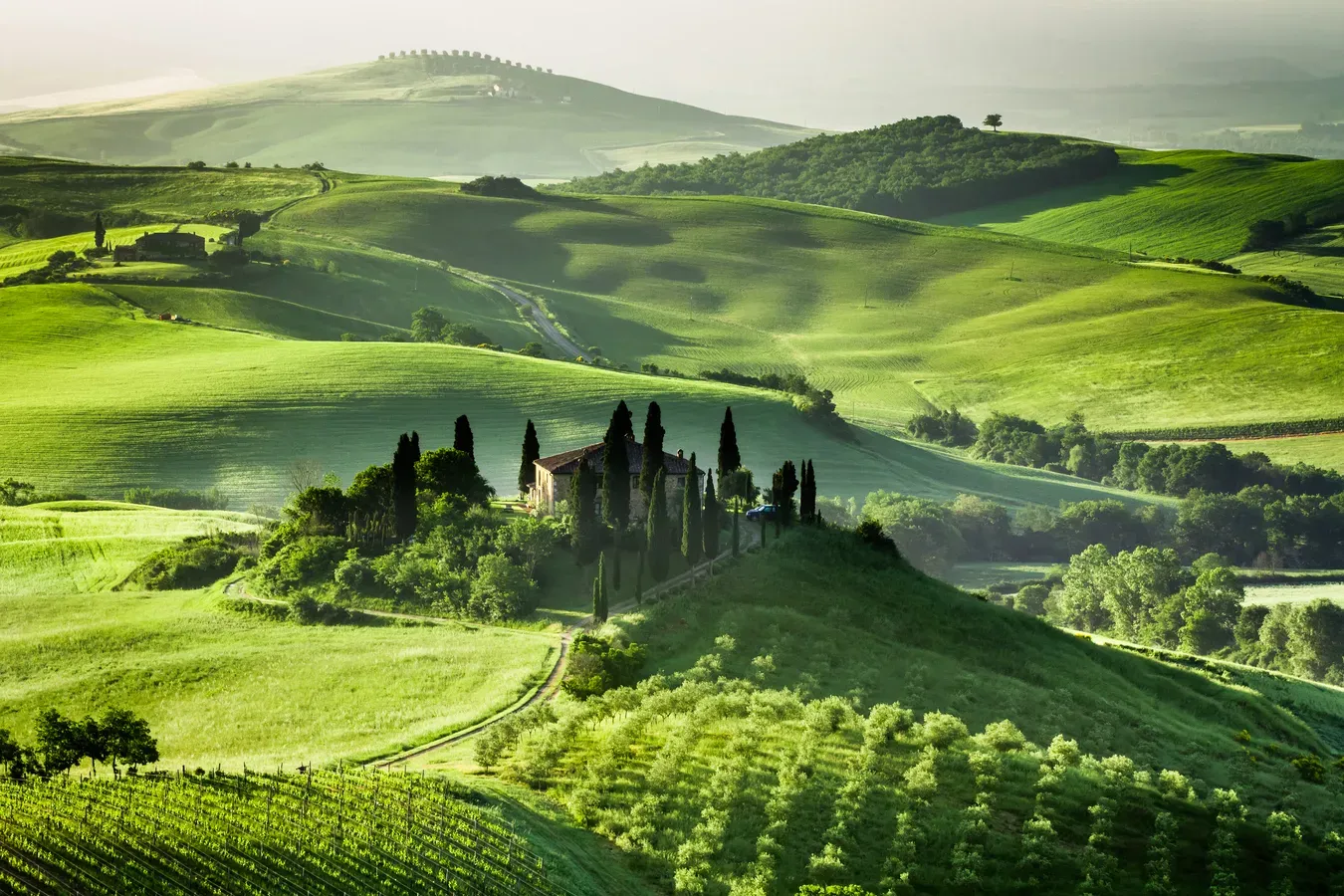
Val d'Orcia in Tuscany epitomizes the picturesque Italian countryside, renowned for its undulating hills, vineyards, and charming towns. This UNESCO World Heritage site is celebrated for its stunning landscapes that have inspired many Renaissance artists.
The region is dotted with quaint towns and villages, each offering unique attractions. Pienza, known as the "ideal city of the Renaissance," is famous for its Pecorino cheese and beautiful Renaissance architecture. Montalcino, nestled on a hilltop, is renowned for its Brunello di Montalcino wine.
San Quirico d'Orcia is another gem, with charming streets and the beautiful Collegiate Church of San Quirico. Bagno Vignoni, with its ancient thermal baths, offers a unique experience with its hot springs right in the village center.
Val d'Orcia's landscape is also characterized by iconic features like cypress-lined roads, rolling fields, and isolated farmhouses. The region's natural beauty makes it a favorite for photographers and nature enthusiasts.
The area is a haven for wine lovers, with numerous vineyards and wineries offering tastings of world-class wines. The combination of natural beauty, historical towns, and culinary delights makes Val d'Orcia an essential destination for those seeking the quintessential Tuscan experience.
23. San Gimignano, Tuscany
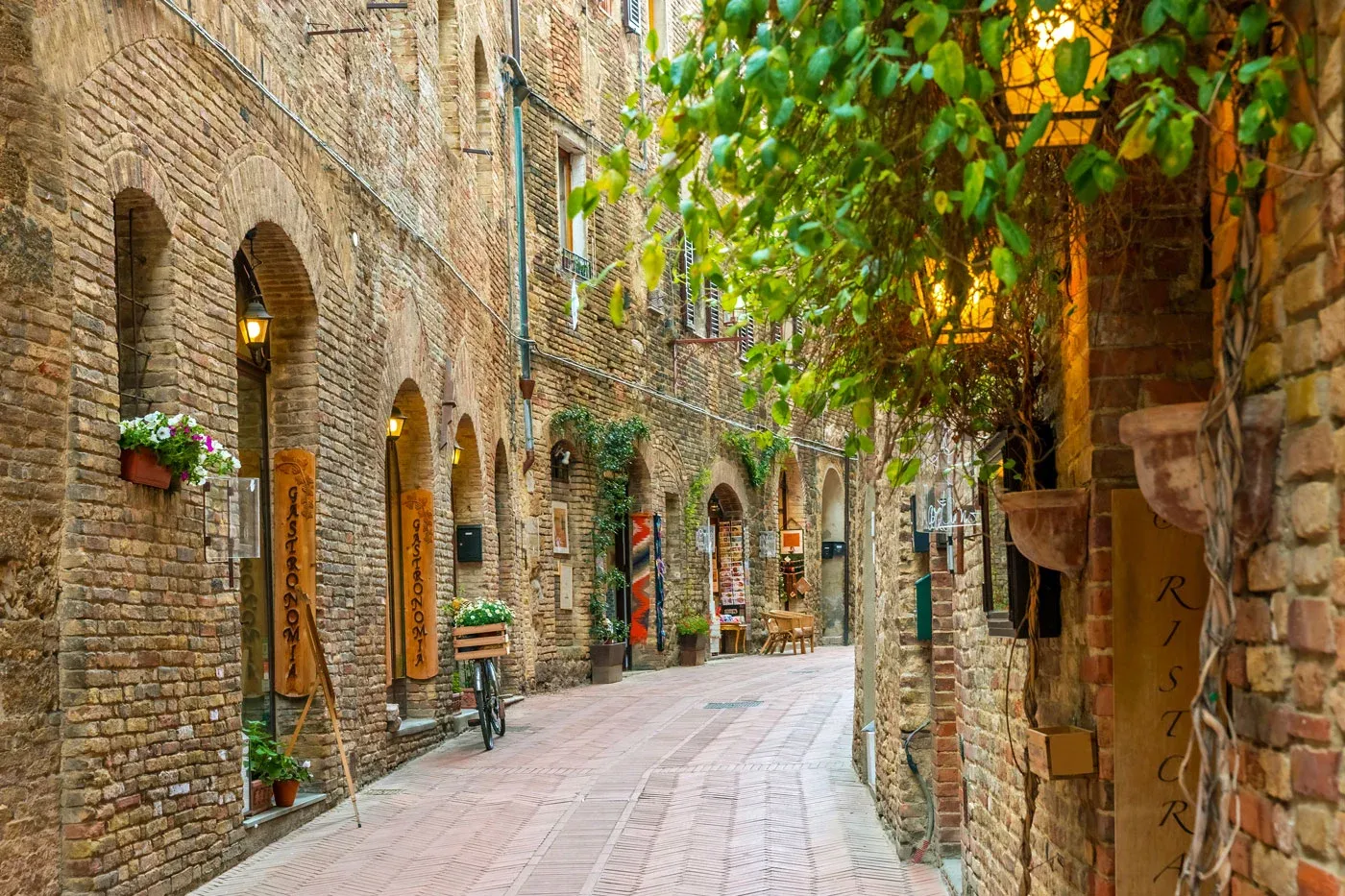
San Gimignano, a medieval hill town in Tuscany, is renowned for its well-preserved architecture and skyline dominated by numerous tall towers. Often referred to as the 'Town of Fine Towers,' San Gimignano offers a vivid glimpse into medieval urban life.
The town's most striking feature is its 14 surviving towers out of the original 72, which were built by wealthy families in the 12th and 13th centuries as symbols of their wealth and power. The Torre Grossa, the tallest tower, offers panoramic views of the town and surrounding countryside.
San Gimignano's historic center, a UNESCO World Heritage Site, is encircled by intact 13th-century walls. Visitors can walk along these walls, exploring the town's narrow streets and squares. The main square, Piazza della Cisterna, is known for its well and beautiful medieval buildings.
The town also boasts significant architectural sites like the Collegiate Church of Santa Maria Assunta, a Romanesque church with remarkable frescoes, and the Palazzo Comunale with its art gallery.
San Gimignano is not just rich in history; it's also known for its white wine, Vernaccia di San Gimignano, and saffron production. The combination of its unique skyline, medieval architecture, and Tuscan charm makes San Gimignano a captivating destination.
24. Milan Duomo

Milan Duomo, the Cathedral of Milan, is a striking example of Gothic architecture and one of the largest cathedrals in the world. This magnificent structure, taking nearly six centuries to complete, stands at the heart of Milan as a symbol of the city's rich cultural and architectural heritage.
The cathedral's exterior is adorned with over 3,400 statues and numerous spires, with the highest one topped by the famous Madonnina, a golden statue of the Virgin Mary. The intricate façade and flying buttresses exemplify the Gothic style.
Inside, the Duomo's vast interior is equally impressive, featuring numerous aisles and stained-glass windows, some of the largest in the world. The stained-glass windows in the choir are particularly notable for their size and artistry. The cathedral also houses the Crypt of St. Charles, containing relics of St. Charles Borromeo.
One of the highlights is the chance to visit the Duomo's roof, where visitors can walk among the spires and enjoy panoramic views of Milan.
Underneath the cathedral lies the Archaeological Area, with remnants of earlier churches and a baptistery, providing insights into the site's long history.
Milan Duomo, with its architectural grandeur and historical significance, is not just a religious site but a landmark that represents the artistic and cultural prowess of Milan.
25. Galleria Vittorio Emanuele II, Milan
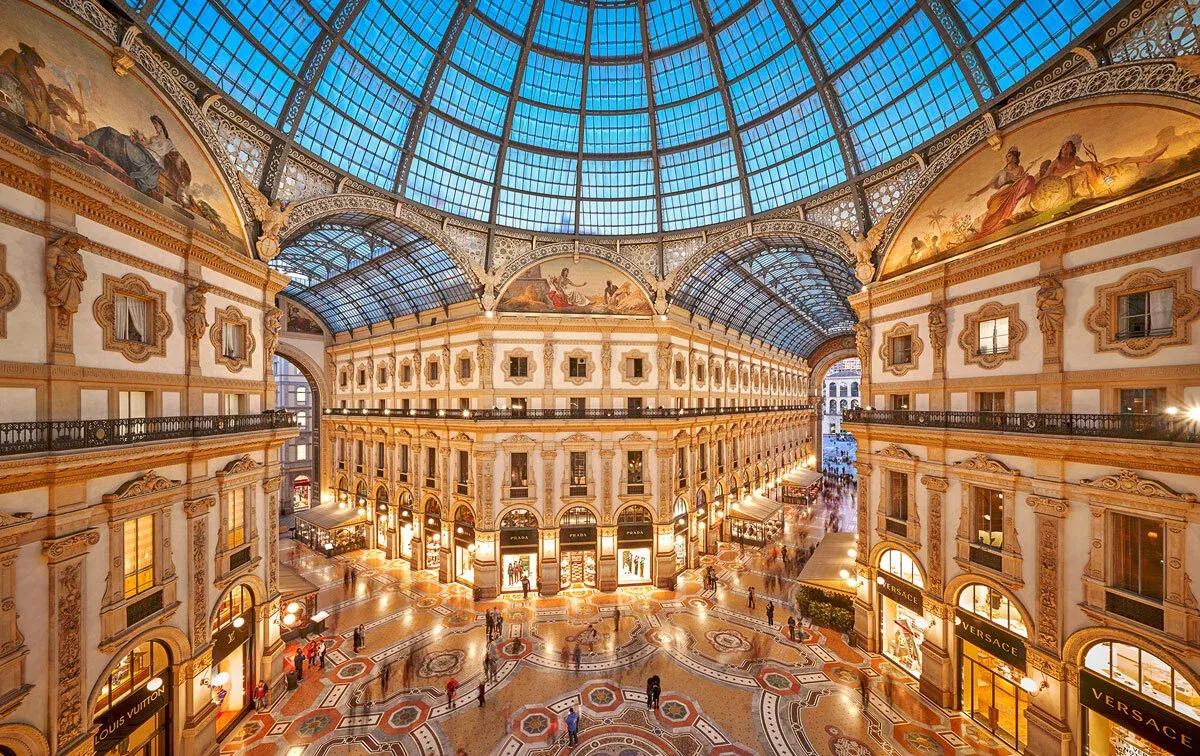
Galleria Vittorio Emanuele II in Milan is one of the world's oldest and most glamorous shopping arcades. Named after the first king of the Kingdom of Italy, this 19th-century structure is famed for its opulent architecture and upscale shopping experience.
The Galleria's grandiose design features a glass and iron roof, creating a bright and airy four-story arcade. The central octagonal space is topped with a stunning glass dome, and the floors are decorated with intricate mosaics, representing the coat of arms of Italy's major cities.
Known as "il salotto di Milano" (Milan's drawing room), the Galleria hosts a range of luxury retailers, historic cafes, and restaurants. Notable establishments include the historic Café Biffi, founded in 1867, and the luxurious Savini Restaurant. The Galleria is also home to some of the world's most prestigious fashion brands and boutiques.
A popular tradition among visitors is to spin on the mosaic bull's testicles, located on the floor of the central dome, which is said to bring good luck.
Connecting Piazza del Duomo and Piazza della Scala, the Galleria is not just a shopping destination but a cultural and social landmark, reflecting Milan's status as a fashion capital and its rich artistic heritage.
26. Lago di Garda
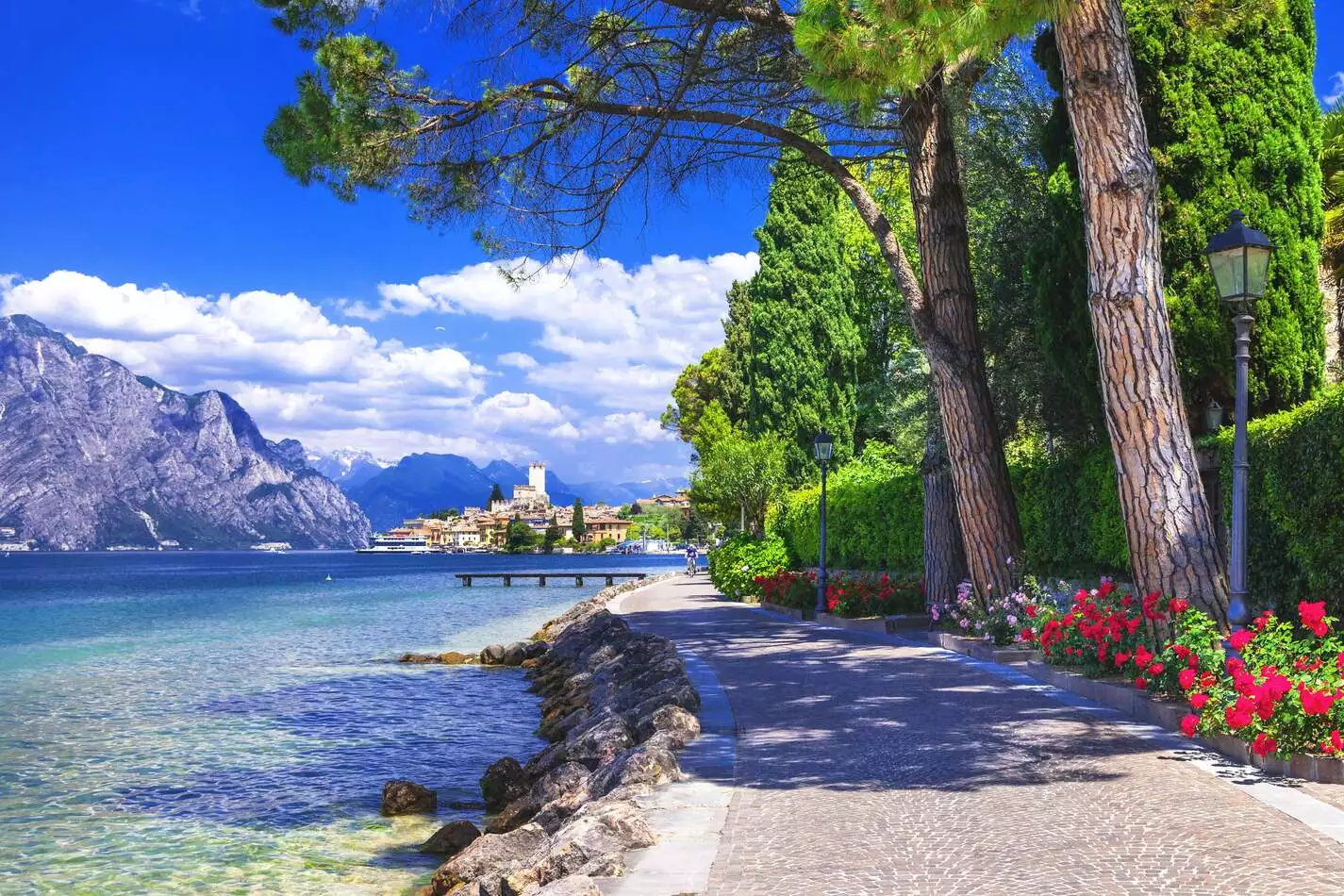
Lago di Garda, Italy's largest lake, is nestled between the Alps and the northern Italian plains, famed for its crystal-clear waters, picturesque towns, and abundant outdoor activities. This stunning lake offers a diverse range of experiences, from relaxed leisure to adventurous sports.
The lake is fringed by charming towns each with its own unique appeal. Sirmione, located on a peninsula, is known for its thermal baths and the historical Rocca Scaligera castle. Riva del Garda, at the northern end, is popular for windsurfing and sailing, thanks to its favorable winds. Gardone Riviera is famous for the Vittoriale degli Italiani, the eccentric home of Italian poet Gabriele D'Annunzio.
Malcesine on the eastern shore is another gem, with the Scaliger Castle and a cable car leading up to Monte Baldo for hiking and panoramic views. The southern part of the lake, with towns like Desenzano and Peschiera del Garda, is known for its lively beaches and nightlife.
For theme park enthusiasts, Gardaland, near Peschiera, is one of Italy’s top amusement parks, offering rides and attractions for all ages.
Lago di Garda's Mediterranean climate, scenic beauty, and the blend of historical charm with modern leisure activities make it a favorite destination for both relaxation and adventure.
27. Verona: Arena and Romeo and Juliet's Balcony
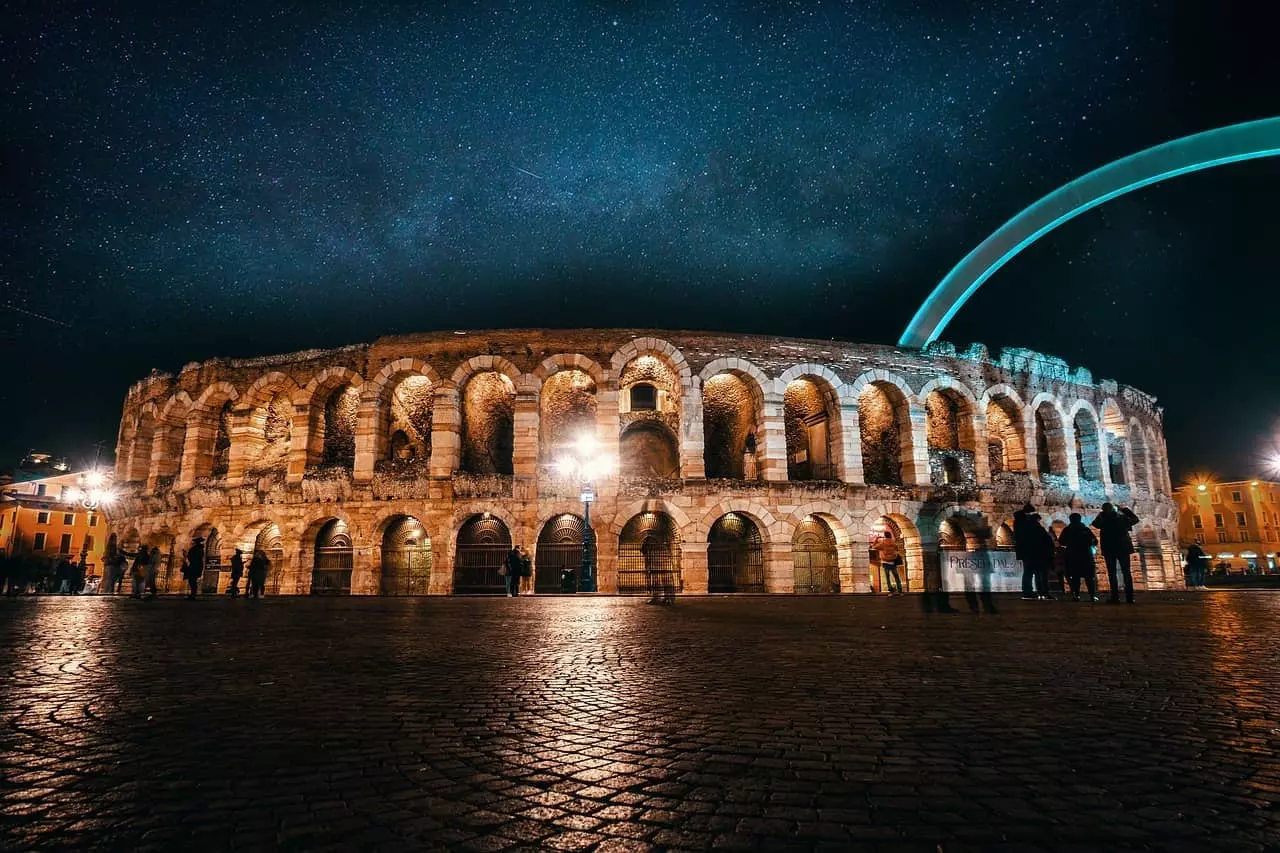
Verona, a charming city in northern Italy, is steeped in history and romance. It's renowned for the ancient Verona Arena, an incredibly well-preserved Roman amphitheater. Built in the 1st century, the Arena is famous for hosting large-scale opera performances and concerts, offering an extraordinary atmosphere with its historic backdrop.
Another iconic attraction in Verona is Juliet's Balcony, a destination that draws romantics from around the world. Located at the Casa di Giulietta, this 14th-century house is said to have inspired Shakespeare's "Romeo and Juliet." Visitors flock to see the balcony and the bronze statue of Juliet located in the courtyard.
The city's historic center, a UNESCO World Heritage Site, is a maze of picturesque streets, squares, and buildings. Piazza delle Erbe and Piazza Bra are vibrant spaces filled with cafes and shops, perfect for enjoying Verona's lively atmosphere.
Verona is also home to other historical sites like the Castelvecchio, a medieval castle and museum, and the Roman Theatre on the banks of the Adige River.
With its blend of ancient Roman structures, medieval architecture, and the allure of Shakespearean lore, Verona offers a rich cultural experience, making it a must-visit destination for history enthusiasts and romantics alike.
28. The Dolomites
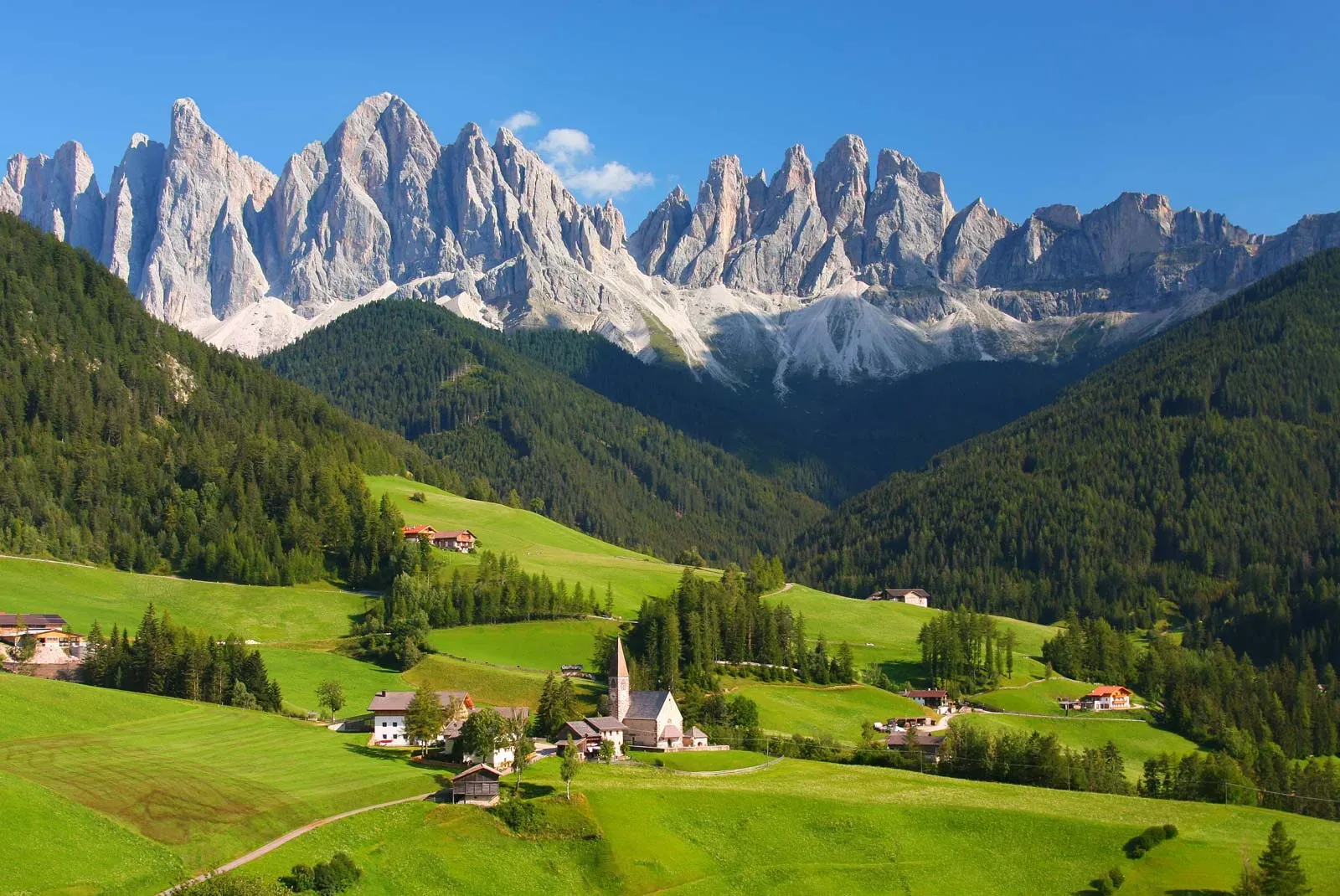
The Dolomites, a majestic mountain range in the Northern Italian Alps, are renowned for their stunning pinnacles, steep cliffs, and deep valleys. This UNESCO World Heritage site offers breathtaking landscapes and a variety of outdoor activities.
The region is famous for its scenic hiking trails and climbing routes, catering to all levels of experience. The Tre Cime di Lavaredo, with its three distinctive battlement-like peaks, is one of the most iconic sights and a popular destination for hikers and climbers.
In winter, the Dolomites transform into a premier skiing destination, with resorts like Cortina d'Ampezzo, Val Gardena, and Alta Badia offering some of the best slopes in Europe. The region is also known for the Sella Ronda, a famous ski route that circles the Sella massif.
For those interested in culture and history, the Dolomites are home to unique traditions and cuisines, with a blend of Italian and German influences. The area’s picturesque villages, like Ortisei and San Martino di Castrozza, provide charming accommodations and traditional dining experiences.
The Dolomites also offer stunning natural parks, such as the Parco Naturale Fanes-Sennes-Braies, with its diverse flora and fauna, providing ample opportunities for nature photography and wildlife spotting. The beauty and diversity of the Dolomites make it a coveted destination for nature lovers, adventurers, and those seeking tranquility amidst spectacular alpine scenery.
29. Lake Braies
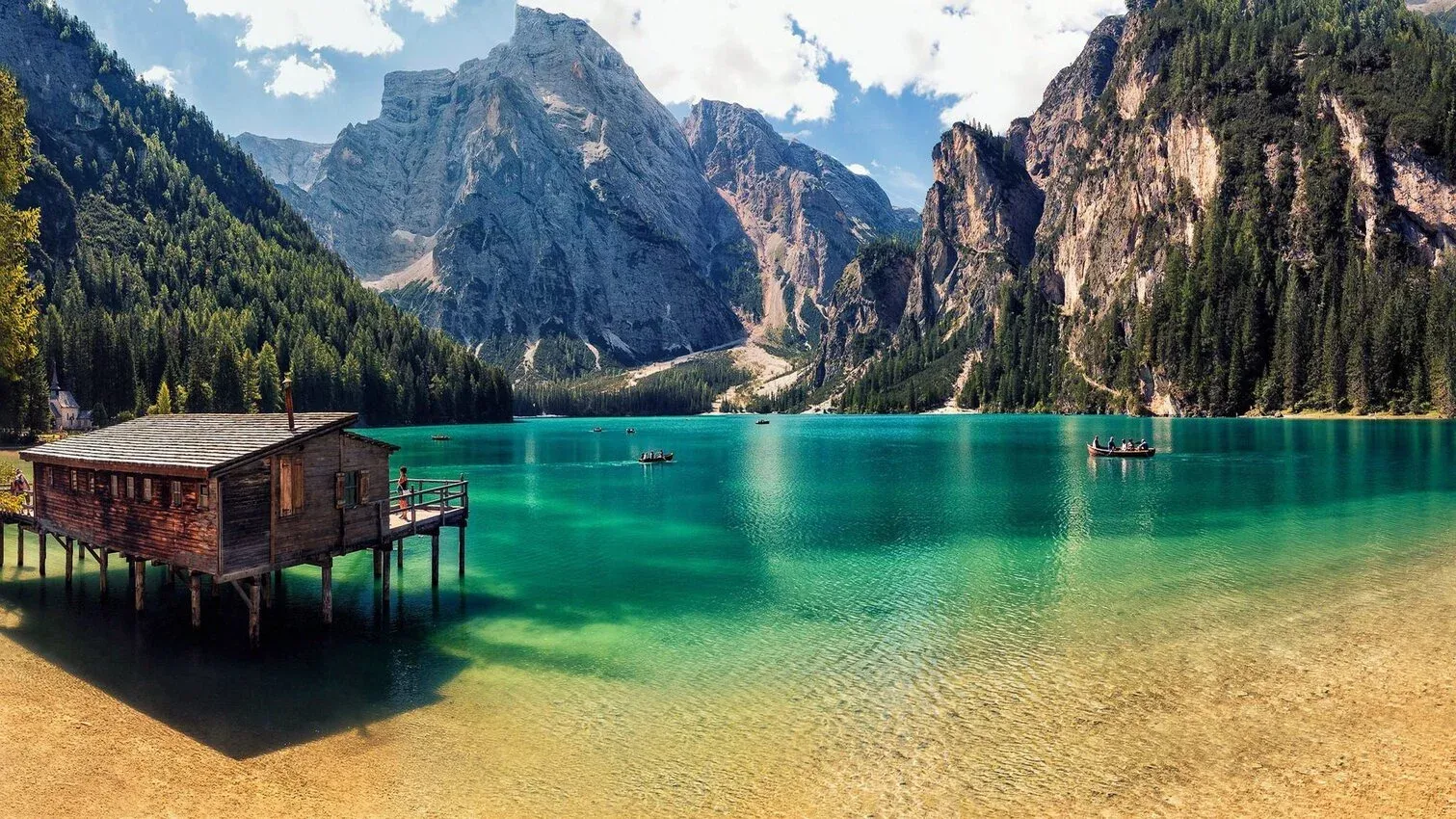
Lake Braies, also known as Pragser Wildsee, is a stunning alpine lake located in the Dolomites of South Tyrol, Italy. Famous for its crystal-clear turquoise waters and breathtaking mountain backdrop, it is often referred to as the "Pearl of the Dolomite lakes."
Surrounded by dense forests and towering peaks, such as the Croda del Becco (Seekofel), Lake Braies offers a serene and picturesque setting. It's a popular spot for hiking, with trails like the Lake Braies Circuit providing panoramic views of the lake and surrounding mountains.
One of the most iconic activities at Lake Braies is boating. Visitors can rent traditional wooden boats to row across the calm waters, enjoying the tranquility and natural beauty of the lake.
In the winter, the lake transforms into a magical winter wonderland, with opportunities for ice-skating and snowshoeing when the lake freezes over. The surrounding area is also a starting point for winter hikes and cross-country skiing trails.
Photographers and nature lovers are drawn to Lake Braies for its scenic vistas and peaceful ambiance. The lake's natural beauty, combined with its accessibility, makes it a must-visit destination for anyone traveling through the Dolomites.
30. The Trulli of Alberobello
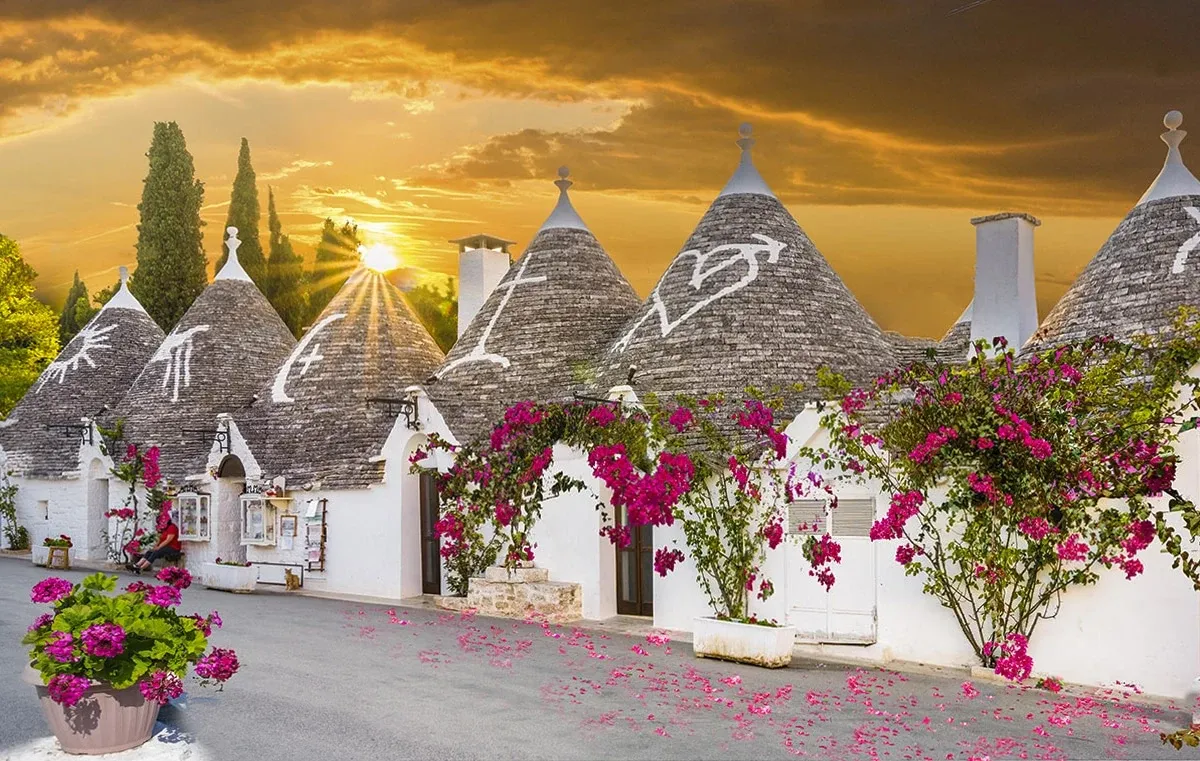
The Trulli of Alberobello are a unique architectural phenomenon located in the Itria Valley of the Apulia region in southern Italy. These traditional dry stone huts, with their distinctive conical roofs, are exclusive to this area and have been designated as a UNESCO World Heritage Site.
Characterized by their whitewashed walls and gray stone cones, the trulli were originally constructed as temporary agricultural dwellings and storehouses. The roofs, built without mortar, are often adorned with symbolic Christian or magical markings and topped with a pinnacle.
The largest concentration of trulli can be found in Alberobello, where entire neighborhoods, like the Rione Monti and Aia Piccola districts, are made up of these unique structures. The trulli here have been converted into homes, shops, restaurants, and even boutique hotels, offering a glimpse into traditional Apulian life.
One of the most famous trulli is the Trullo Sovrano, the only two-story trullo, which has been turned into a museum. Inside, visitors can explore the traditional layout and furnishings of a trullo home.
The Trulli of Alberobello are not just remarkable for their architectural ingenuity but also for their cultural significance, representing a unique and enduring aspect of rural Italian history and culture.
31. Matera's Sassi, Basilicata
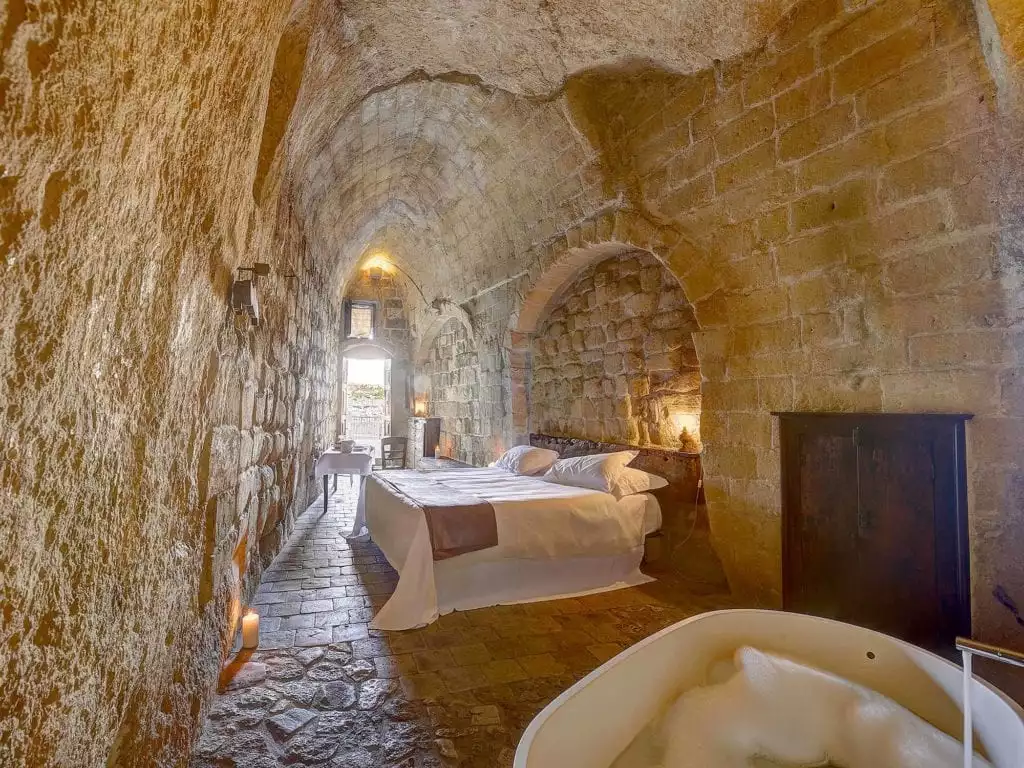
Matera's Sassi are ancient cave dwellings in the Basilicata region of Southern Italy, recognized for their historical depth and distinctive architectural form. These remarkable troglodyte settlements, carved into limestone, represent some of the earliest human settlements in Italy, dating back to the Paleolithic era.
The Sassi are divided into two districts: Sasso Caveoso and Sasso Barisano. Sasso Caveoso has retained a more ancient structure, with houses dug into the rock and resembling the area's original prehistoric dwellings. Sasso Barisano, on the other hand, has been more developed with facades of homes and streets, giving it a more urban feel.
A standout feature of Matera is the Church of Santa Maria de Idris, a rock church that showcases frescoes and carvings directly on the cave walls. Another significant site is the Casa Grotta di Vico Solitario, a furnished cave dwelling that provides insights into the traditional life of the Sassi's inhabitants.
The area also includes modern attractions, such as boutique hotels, restaurants, and shops, all seamlessly integrated into the ancient caves.
Matera's Sassi is not only a UNESCO World Heritage site but also served as the European Capital of Culture in 2019. Its blend of historical significance, cultural richness, and unique landscape makes it a fascinating destination for history enthusiasts and travelers seeking an off-the-beaten-path experience.
32. Craco, Basilicata
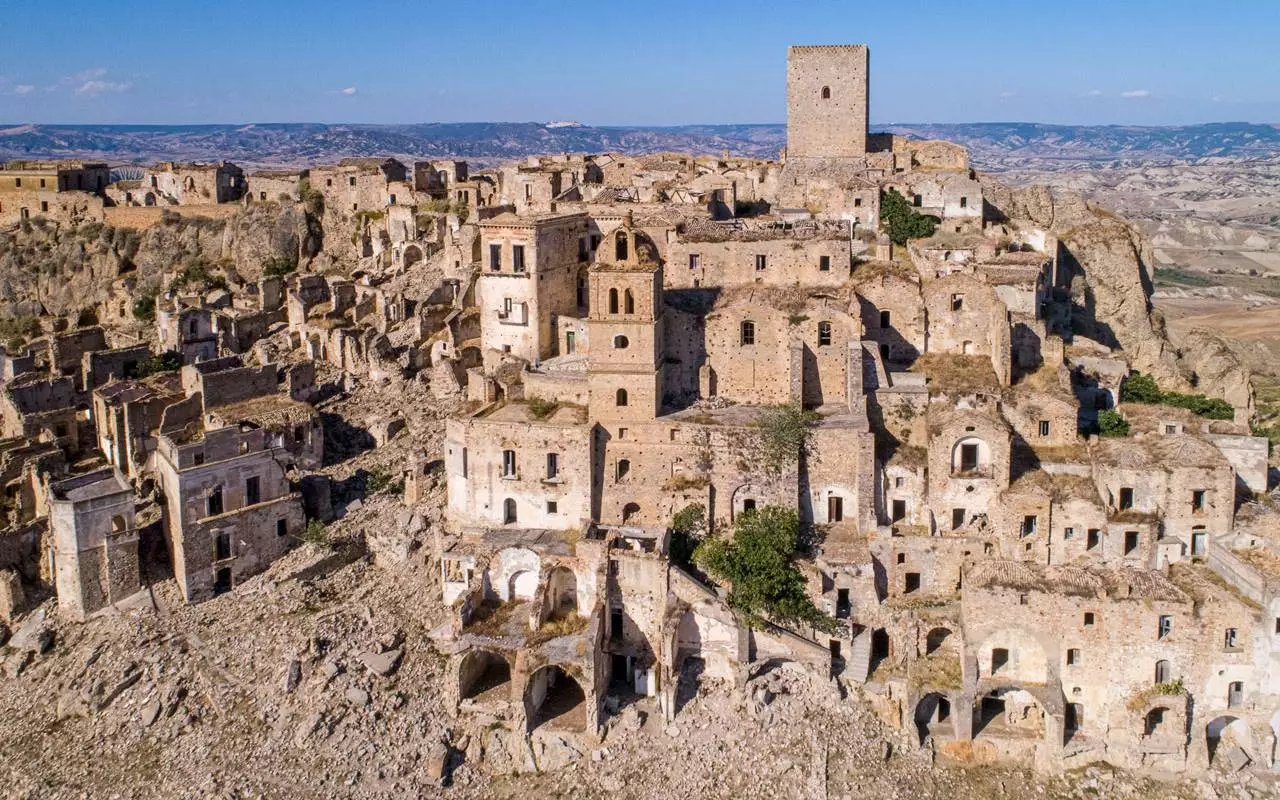
Craco, located in the Basilicata region of Southern Italy, is a captivating ghost town with a unique history and dramatic landscape. Once a bustling medieval village, Craco was gradually abandoned due to natural disasters and geological instability, leaving behind a haunting and picturesque ruin perched atop a cliff.
The town's abandonment began in the 20th century, primarily due to landslides and earthquakes, which made the area unsafe for inhabitants. Today, Craco's deserted streets, derelict buildings, and the remains of the ancient infrastructure provide a fascinating glimpse into the past.
A key feature of Craco is its Norman Tower, part of the old castle that dominates the town's skyline. The San Nicola Vescovo church, with its partially collapsed bell tower, adds to the eerie yet captivating atmosphere.
Craco has become a popular site for photographers and filmmakers, drawn by its stark beauty and the sense of history frozen in time. The town is also a destination for guided tours, offering visitors a chance to safely explore the abandoned streets and learn about its history and the reasons for its decline.
The allure of Craco lies in its transformation from a thriving medieval village into a ghost town, making it a unique and evocative destination for those interested in history, archaeology, and the poignant beauty of abandoned places.
In conclusion, Italy's landmarks are a tapestry of history, art, and natural beauty that weave together to tell the rich and varied story of the country. From the ancient ruins of Rome and Pompeii to the Renaissance splendors of Florence and the picturesque landscapes of the Amalfi Coast and the Dolomites, each landmark offers a unique glimpse into Italy's soul.
Whether it's the romantic canals of Venice, the tranquil beauty of Lake Como, or the rustic charm of Tuscany's rolling hills, these sites captivate the hearts of travelers. They are not just attractions but symbols of Italy's enduring legacy in art, architecture, and culture.
Exploring these landmarks is more than a journey through places; it's an exploration of the history, creativity, and spirit that make Italy a timeless and unforgettable destination.


